Review: Chisinau to Iasi Train CFM Moldovan Railways
This review details a trip between Chisinau (Moldova) and Iasi (Romania) on a CFM Moldovan Railways train.
From Chisinau to Iasi
If you want to travel by train between Moldova and Romania, you have the choice out of two options.
Among foreign tourists, the Prietenia night train linking the Romanian capital of Bucharest with the Moldovan capital of Chisinau is arguably the most popular.
However, it’s also possible to travel between Moldova and Romania by daytime trains.
There are two train departures each day between Chișinău and Iași, the largest city in north-eastern Romania.
Although frequent minibuses ply this route as well, the train makes for a more comfortable alternative than the cramped seats inside these vehicles.
In this review, I will detail the experience on board the Chisinau to Iasi train and show you everything you need to know about booking your tickets and onward connections.

Booking your ticket
The train service between Chisinau and Iasi is operated by the Moldovan Railways (Calea Ferată din Moldova), which is usually abbreviated as CFM.
You can simply buy your ticket at the train station or online at the Moldovan Railways website.
Although the website is not available in English, it’s very straightforward to book your ticket.
Simply go to “bilet online” and click on “Chișinău – Iași-Socola – Chișinău” in the drop-down menu.
A new booking window will now open, which does have the option to switch to English.
Here, you select your preferred date and train between Chisinau and Iasi as well as your travel class.
A one-way ticket between Chisinau and Iasi costs just 130 Moldovan lei (€6.30) in first class, while a second class ticket costs 100 MDL (€4.85) and a third class ticket 90 MDL (€4.35).
You can select your exact seat on the train when clicking on the seat number that is listed under “place selecting”, as this will open the seat map for the train.
The online booking system looks a bit basic but works like a charm.
After entering your personal details and passport number, you will be transferred to the payment page where you simply pay with your debit- or credit card.
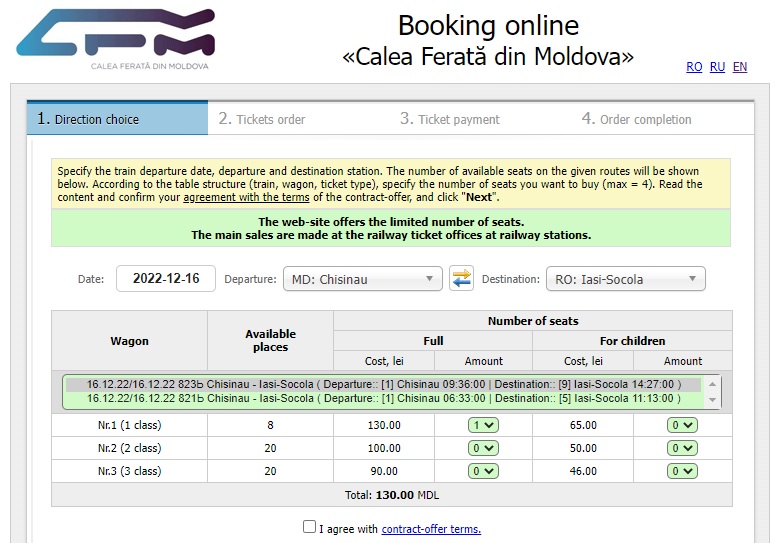
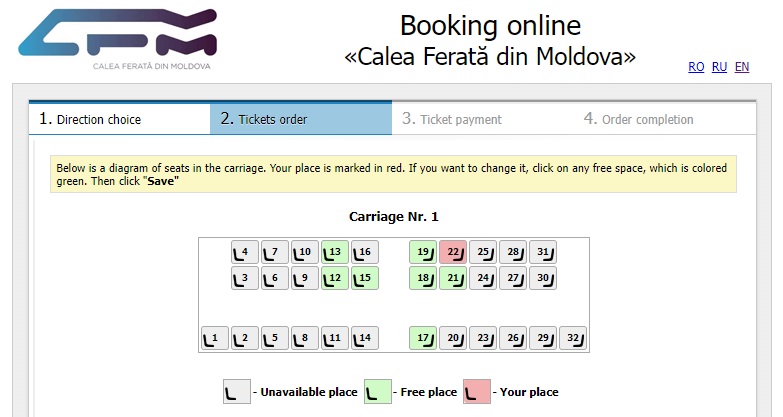
Chisinau station
I took the early morning train from Chisinau to Iasi, which departs the city’s main station at 6.33am.
When I arrived at the station some 20 minutes before departure, there was already a flurry of activity at the platform.
Dozens of people were boarding the train, with many of them being waved off by friends and family.
If you have bought an e-ticket for the Chisinau to Iasi train, you simply show your booking confirmation to the CFM conductor waiting at the train door.
He will tick off your name from a list and hand you an old-fashioned paper ticket.
The Chisinau-Iasi train is operated by a Soviet-era DMU (Diesel Multiple Unit) train originally made by Hungarian company Ganz-MAGAV somewhere between the 1960s and 1980s.
However, these CFM trains have all been completely refurbished and modernised in recent years by a Romanian company called Electroputere VFU and no longer resemble their original design.
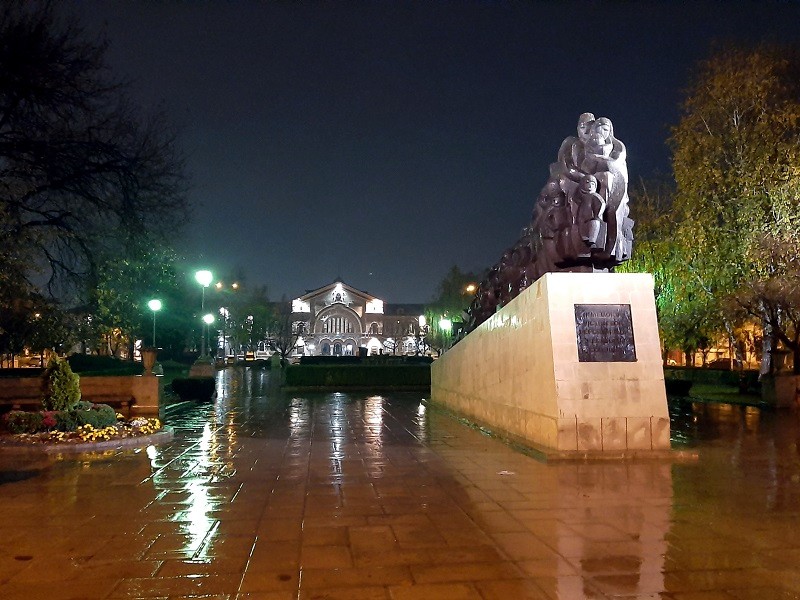
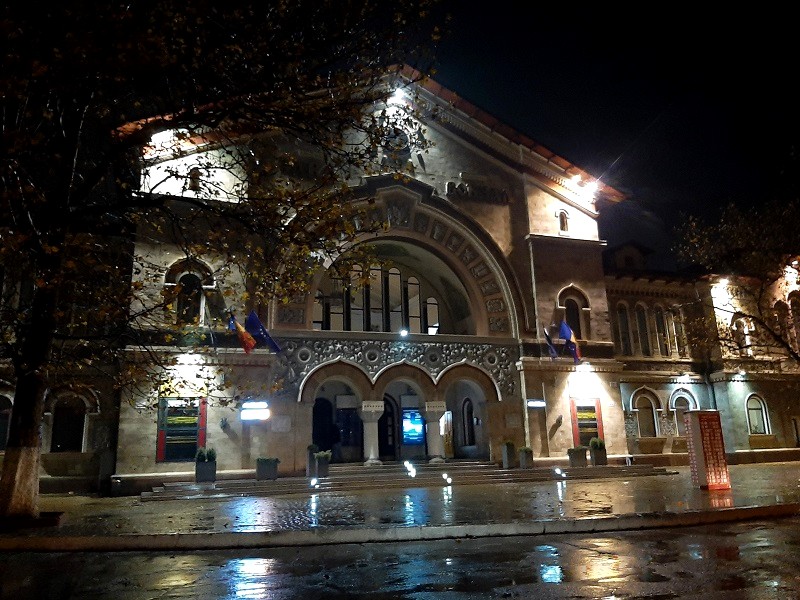


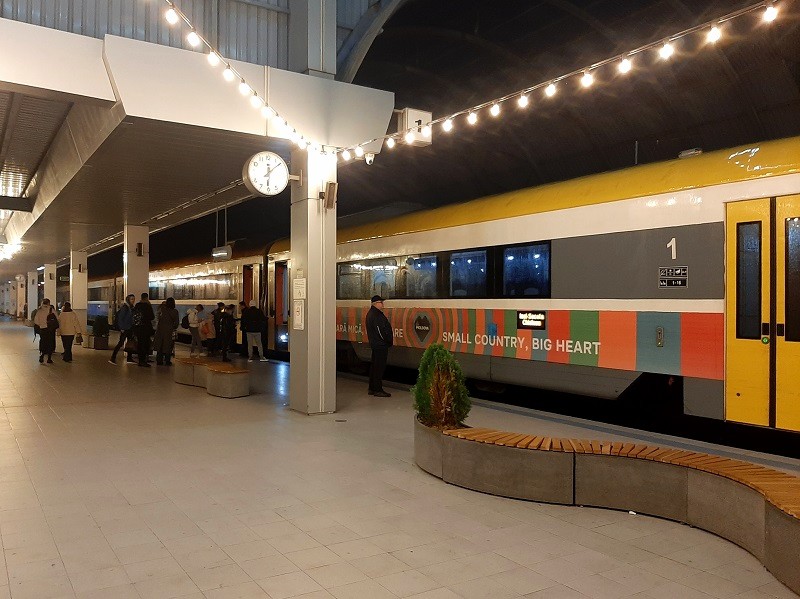
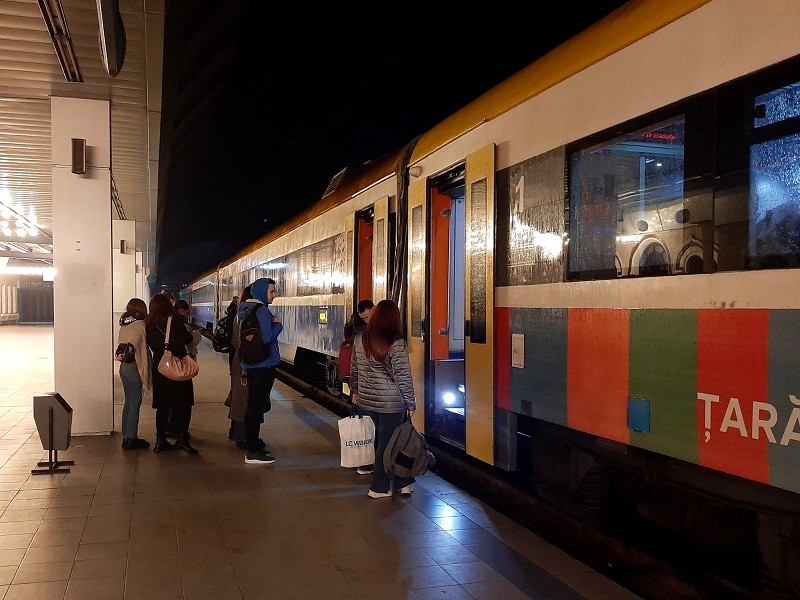
On board the Chisinau-Iasi train
As a first class ticket between Chisinau and Iasi was only €6.30, this was obviously where I chose to sit on the train.
Seats in first class on this CFM train are in a 1-2 configuration, with the duo seats at one side of the aisle being ideal for couples or friends travelling together and the solo seats at the other side of the aisle being perfect for those travelling alone.
The first class seats are fairly comfortable and have a decent amount of legroom.
They all have access to a power socket and a fold-out table – with the exception of the seats in the middle of the carriage as these are located around a fixed table.
Second class seats are in a 2-2 configuration and are still perfectly acceptable for a short train journey.
Third class seats however are certainly a bit more cramped as they are in a 2-3 configuration.
Given that the difference between third and second class is only €0.50 I really can’t imagine any foreign tourist selecting this option unless you are a particular penny pincher or a masochist.
All seats in both second and third class have access to power sockets as well.
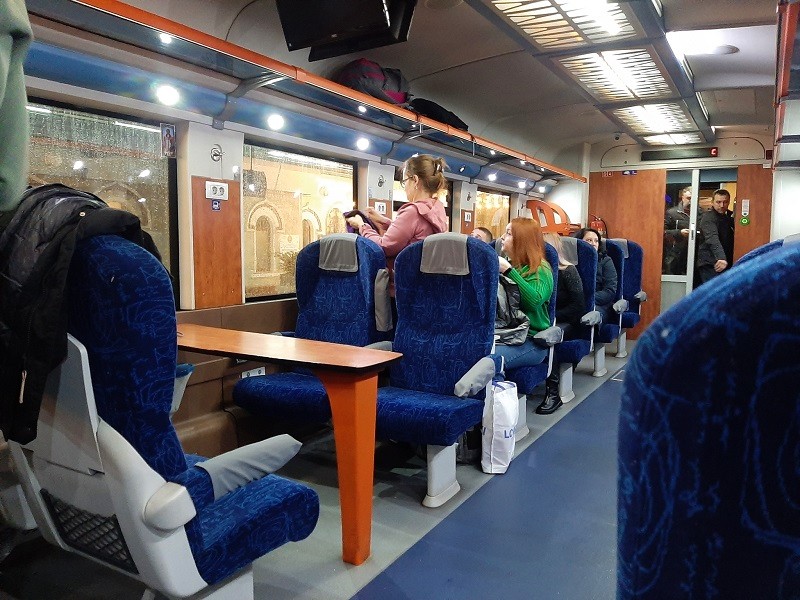

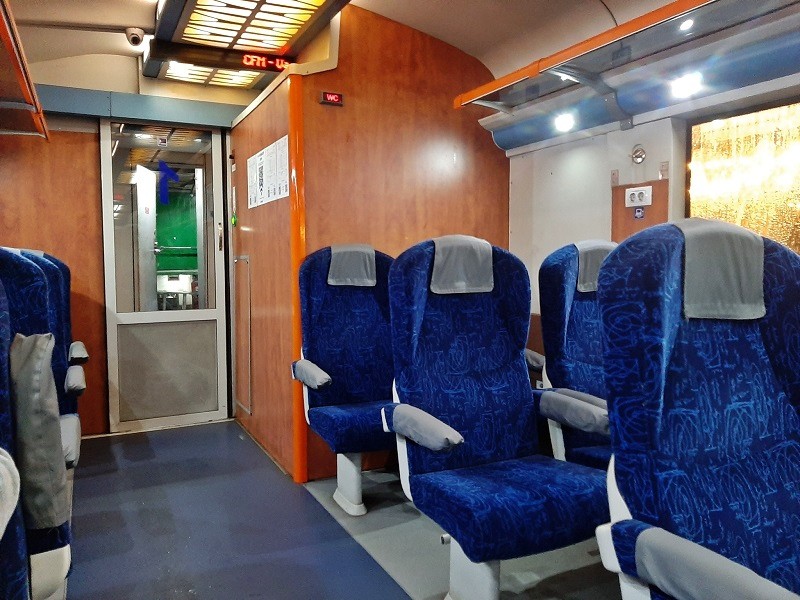
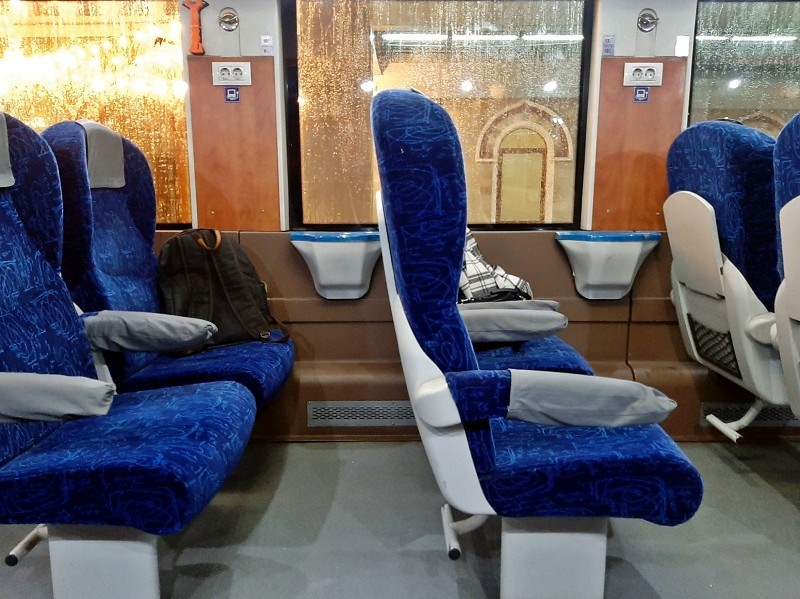
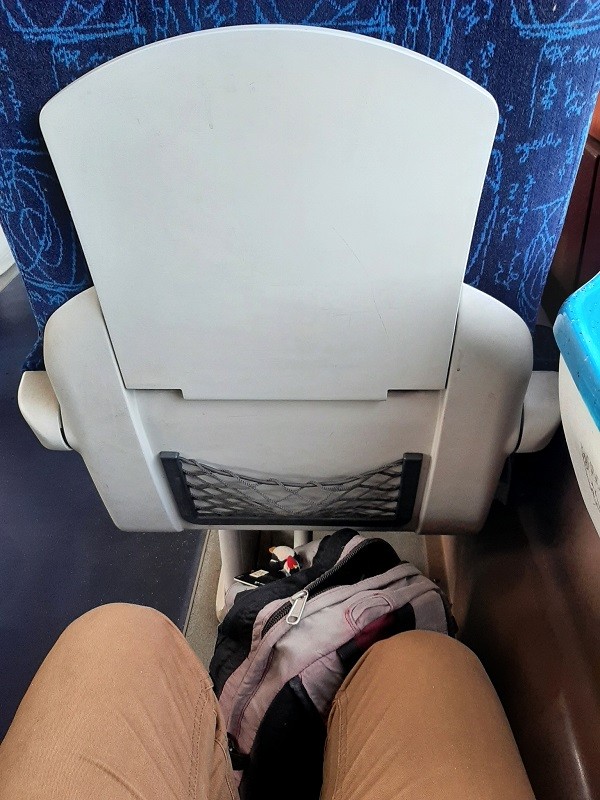
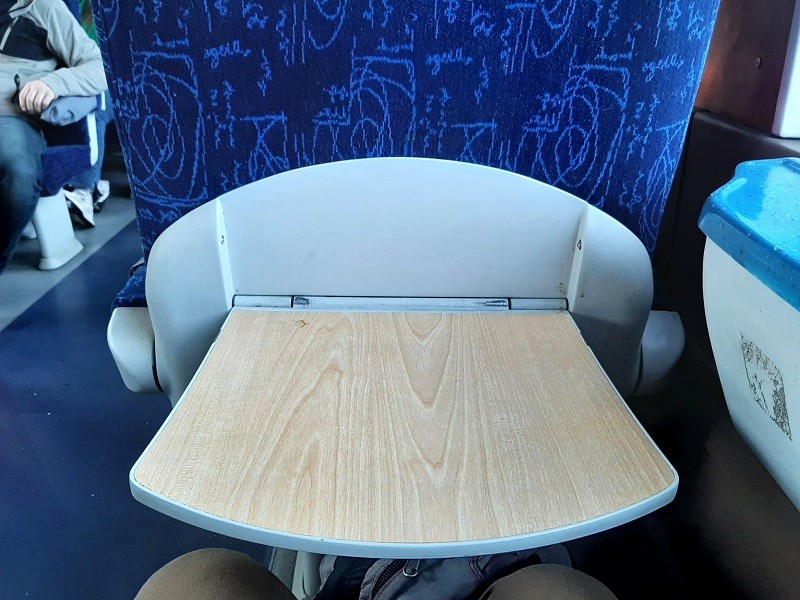


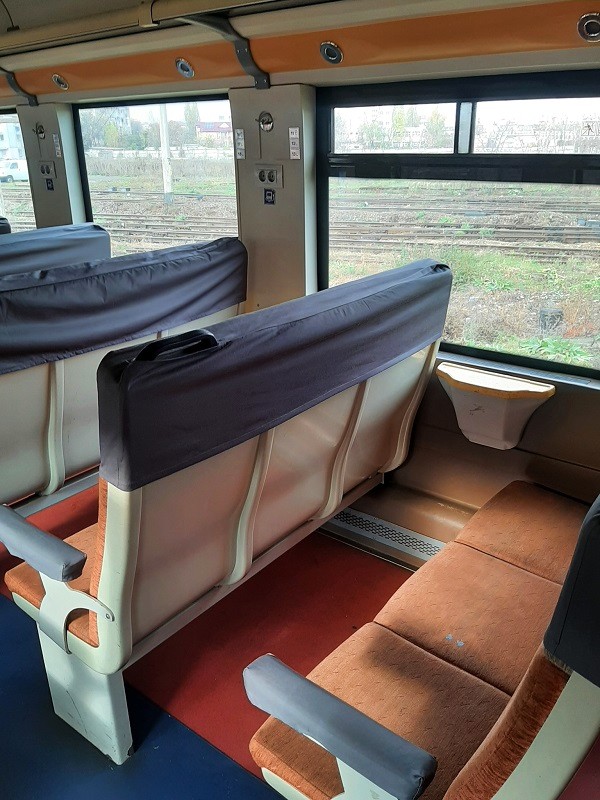
CFM Train Chisinau to Iasi Socola
Train 821Ь – Departure: 6.33am – Arrival: 11.13am
Duration: 4h40m – Distance: 126 kilometres
First class seat – Costs: 6.30 EUR
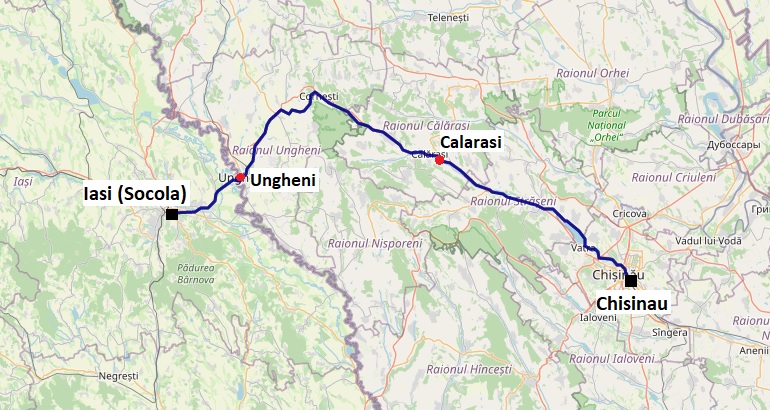
Departure
It was already raining cats and dogs when I walked in the early morning towards the railway station and unfortunately the poor weather continued right after departure.
Coupled with the early morning darkness, it meant that visibility was poor.
Only about 40 minutes or so after departure did the rain finally stop and daylight appeared.
If you do have good weather and daylight upon departure, there are some pretty views on your left-hand side when the train rides along the shores of Lake Ghidighici just outside of Chisinau.
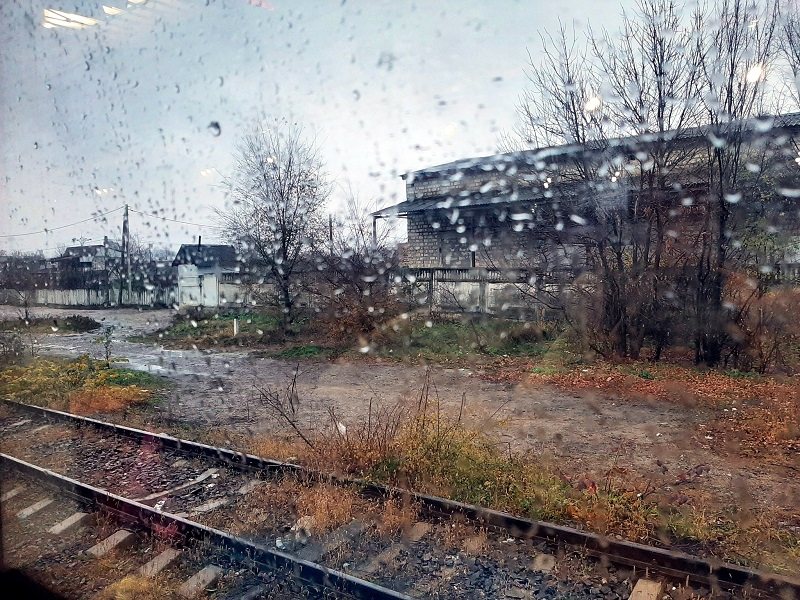
Food and drinks
Due to the early departure, I didn’t manage to have breakfast.
Fortunately, the train has a small bar counter in the 2nd class carriage selling coffee, cold drinks (including alcohol) and basic snacks.
The Lavazza coffee was strong and hit the spot, although the 7 Days croissant (which you’ll find everywhere around Eastern Europe) was certainly less impressive and tasted like cardboard.
Make sure you bring some Moldovan or Romanian lei in cash if you want to buy some food or drinks on board the train, as I don’t think card payments are accepted.

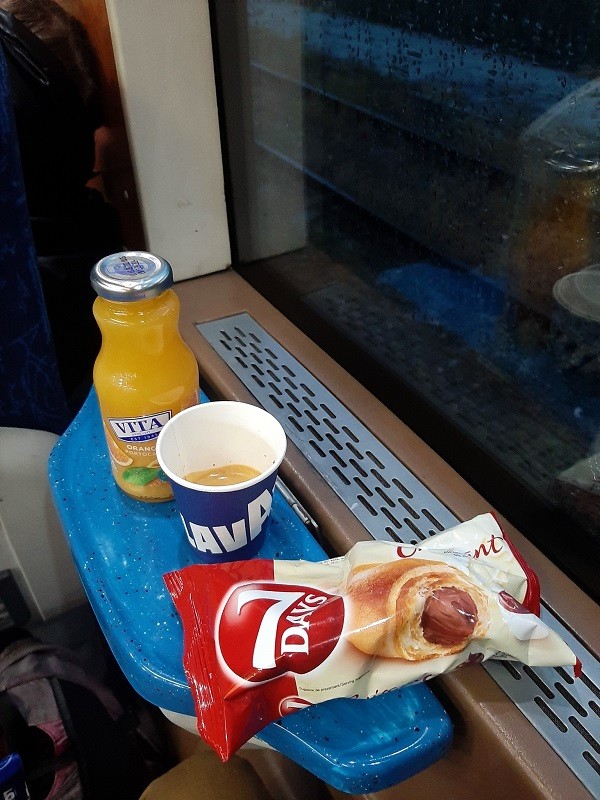
Facilities on board the train
As the CFM train features both power sockets and WiFi internet, you can actually get some work done on your laptop when travelling in first class.
If you want to connect to the WiFi network, you have to scan a QR code on a poster at the end of each carriage.
The WiFi internet only works when the train is in Moldova and won’t work on Romanian territory on its final approach towards Iasi.
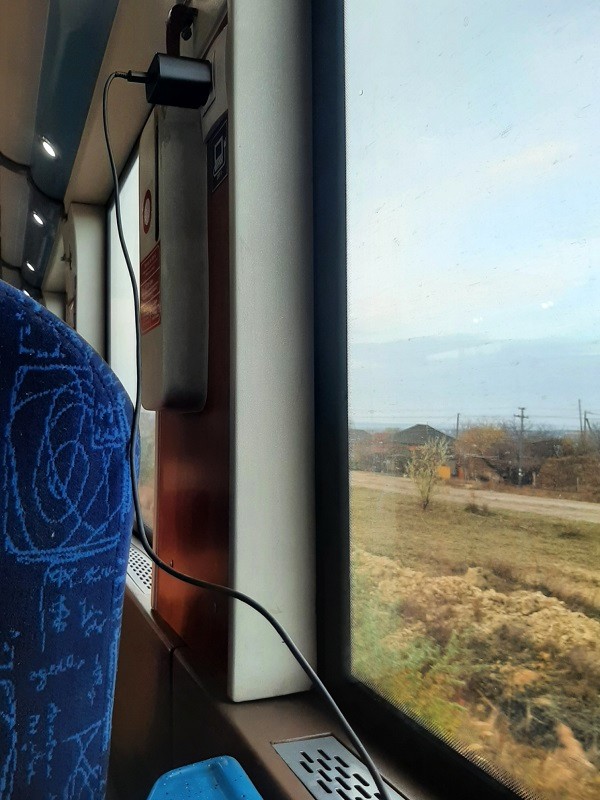
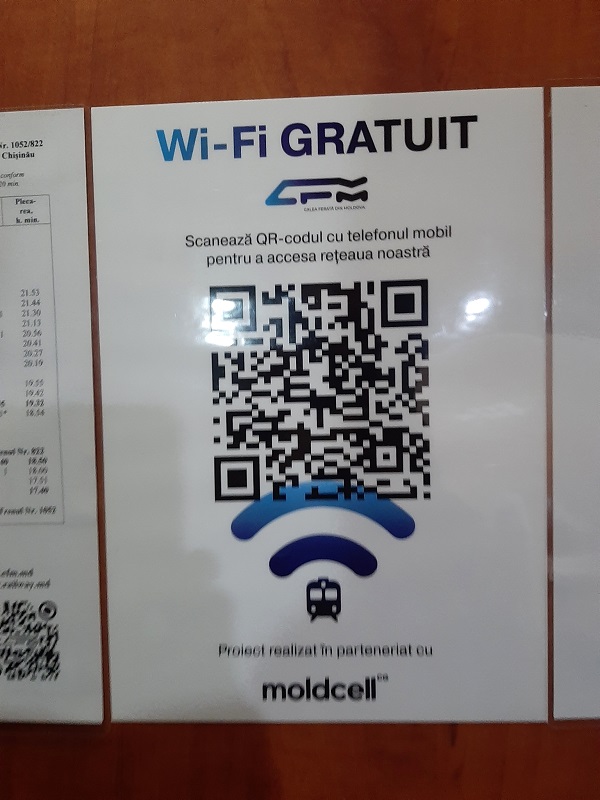
Towns and stations
Although Moldova is a pretty country and there are some interesting things to see as a tourist, it can feel like a rather dreary place if you travel in late autumn or winter when the weather is bad.
Indeed, the fields and towns of Moldova felt particularly gloomy when I took the train from Chisinau to Iasi.
However, it’s still fun to watch the views of towns and station from the window and to get some glimpses of rural Moldova.
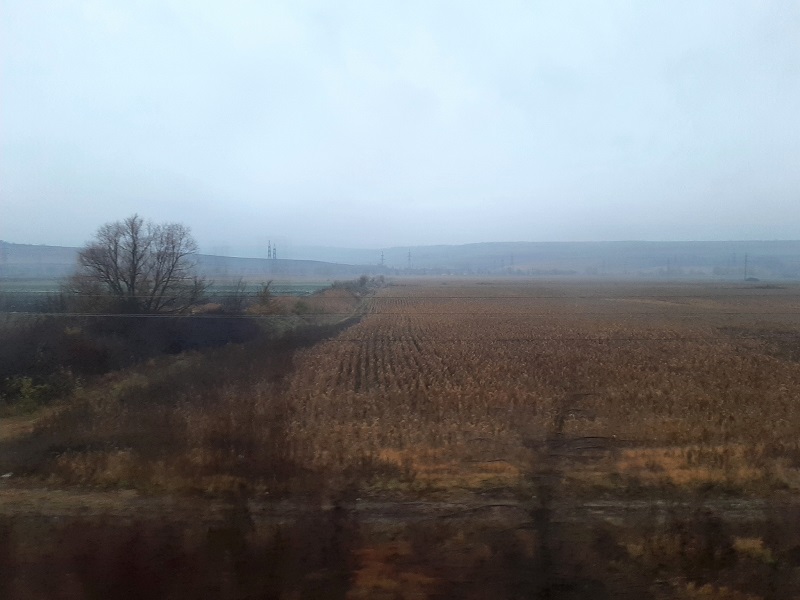
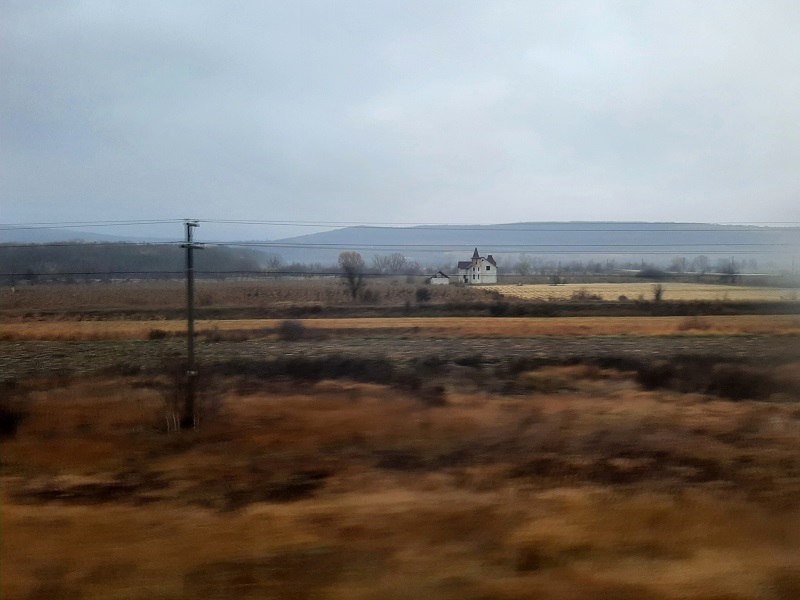
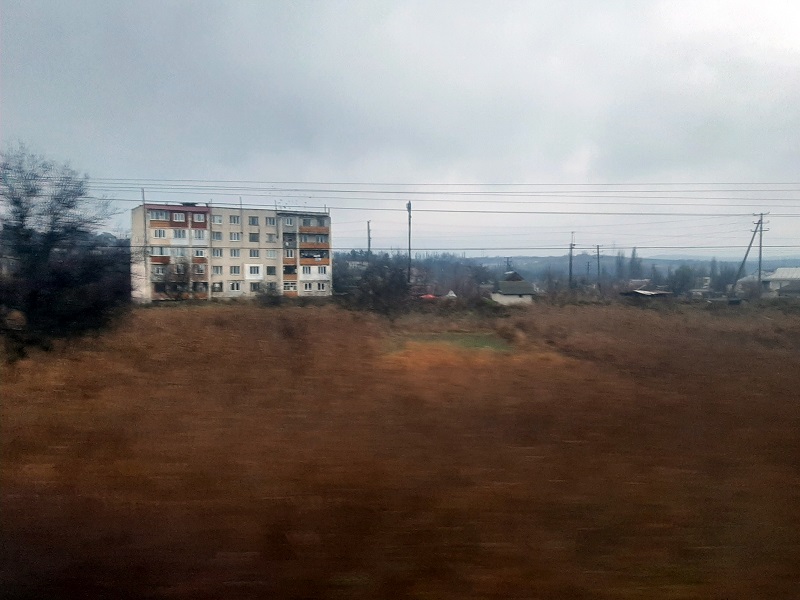
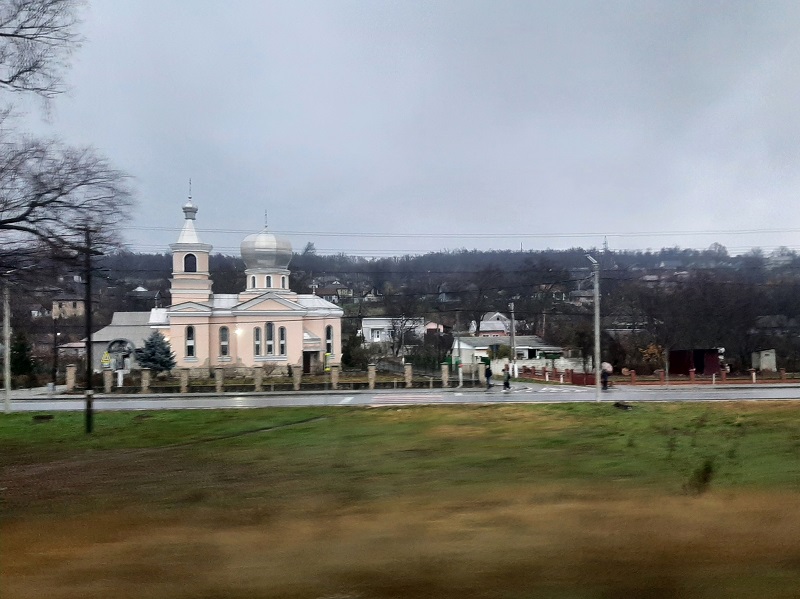
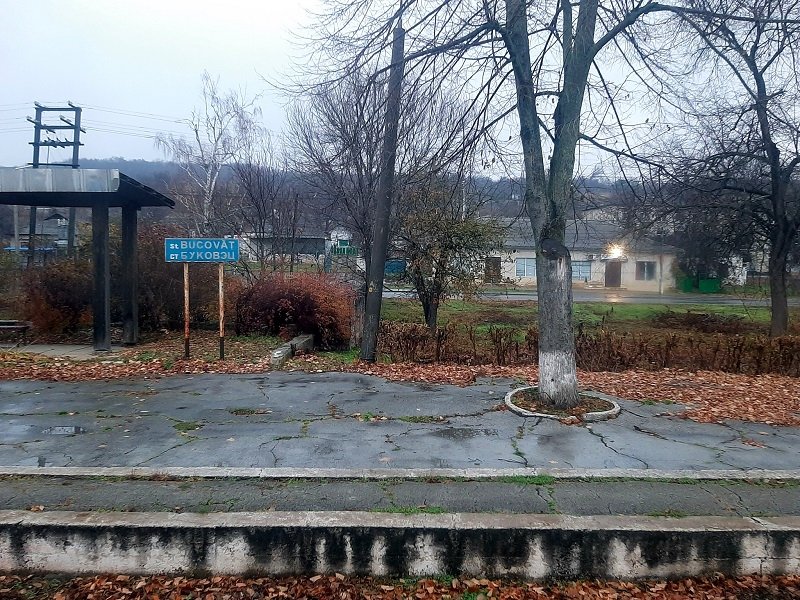
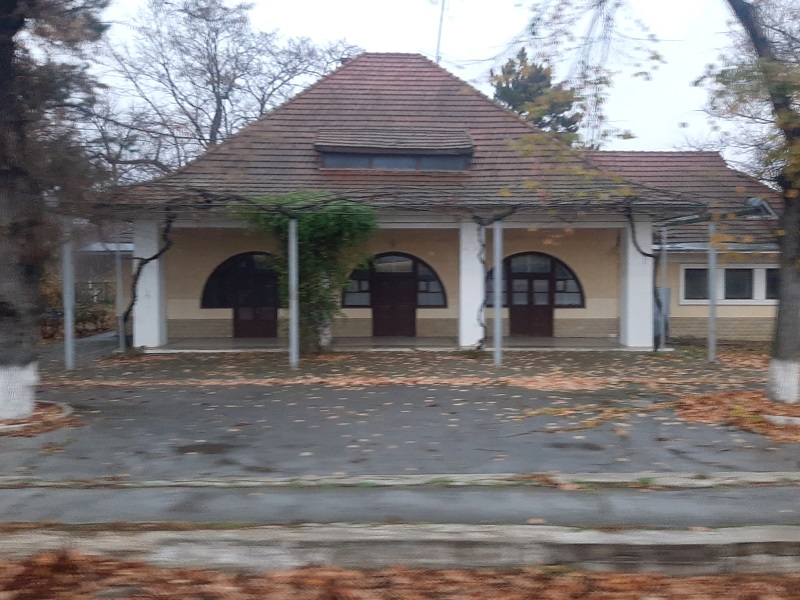
Călăraşi
About halfway through the journey from Chisinau to the Romanian border, the train stops at the station of Călăraşi.
Just one or two people disembarked the train and I don’t think more than two or three people got on board the train at this station.
Indeed, also at other stops along the route only a small number of people got on or off the train as almost everyone on board seemed to travel from Chisinau all the way to the last stop at Iasi.
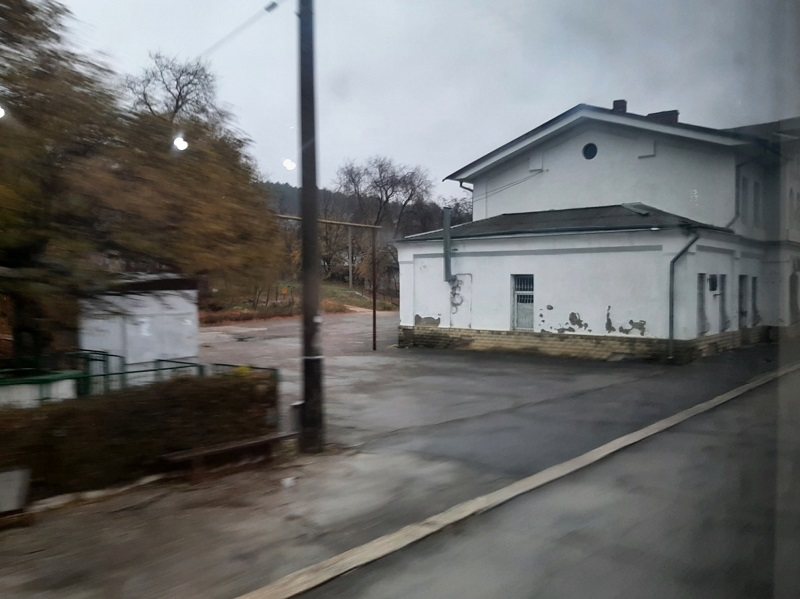
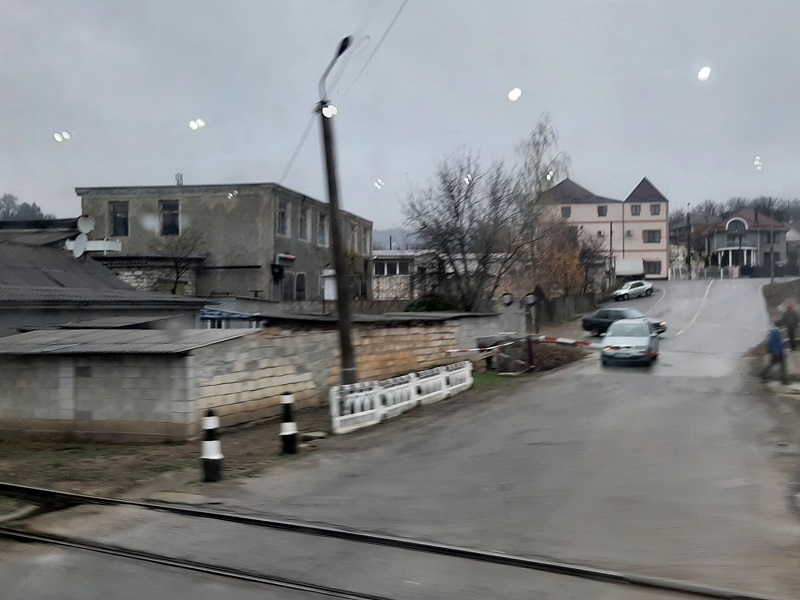
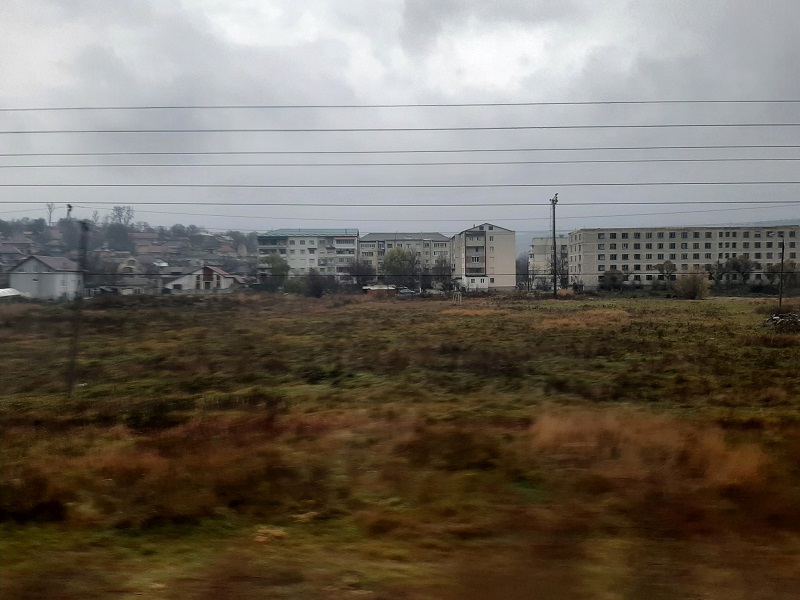
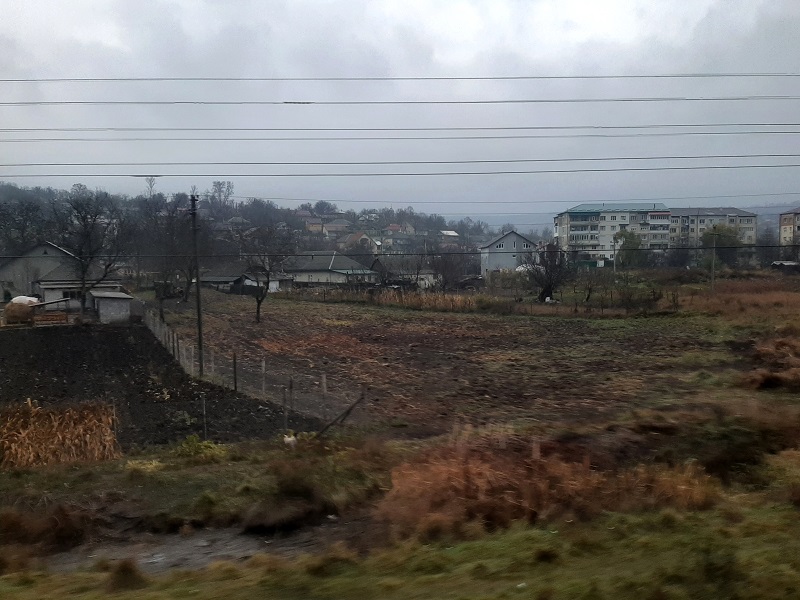
Sipoteni
When the train approached the small town of Sipoteni, the sky turned into dark blue storm colours again.
Around Sipoteni you will notice that the landscape slowly starts to turn more hilly.
Fortunately, there wasn’t much rain this time around, so I could still enjoy the scenery from the window.
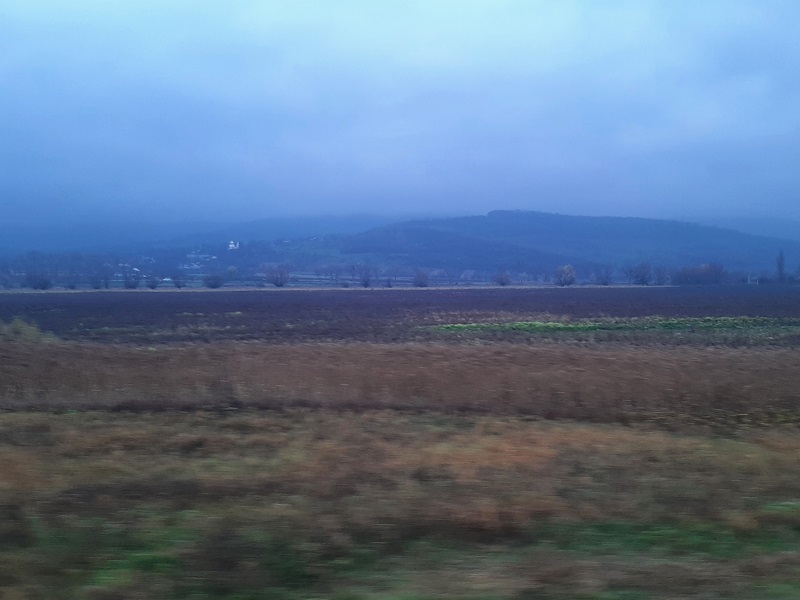
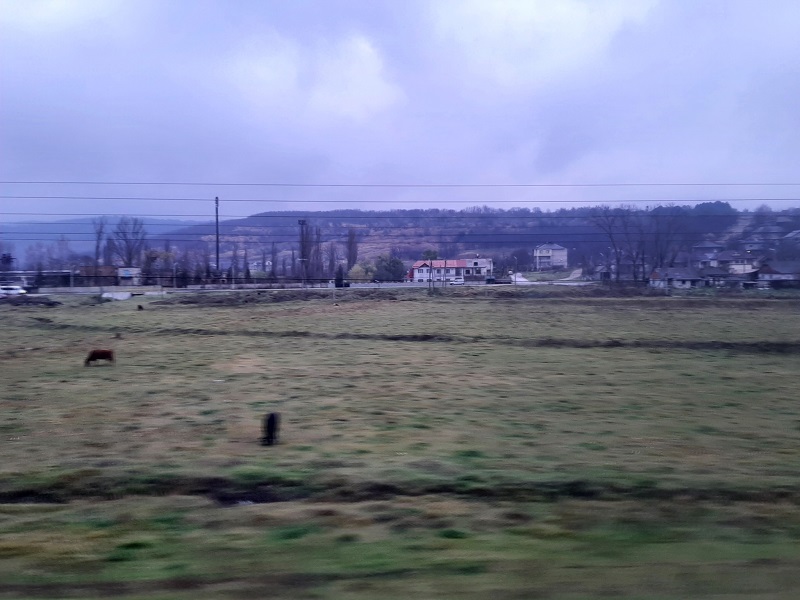
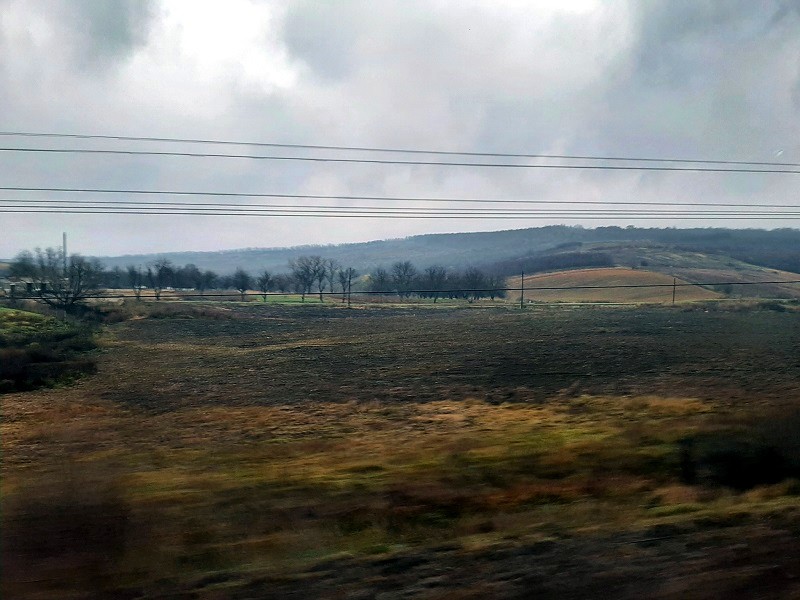
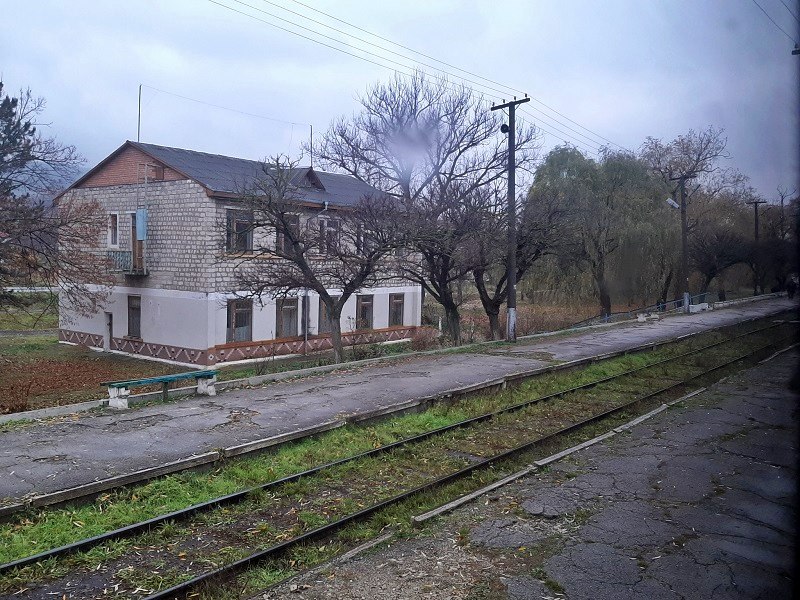
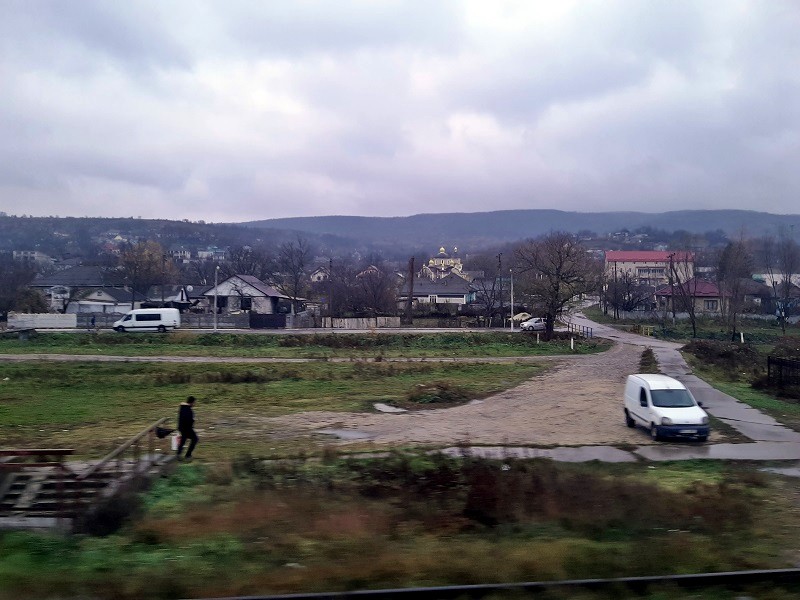
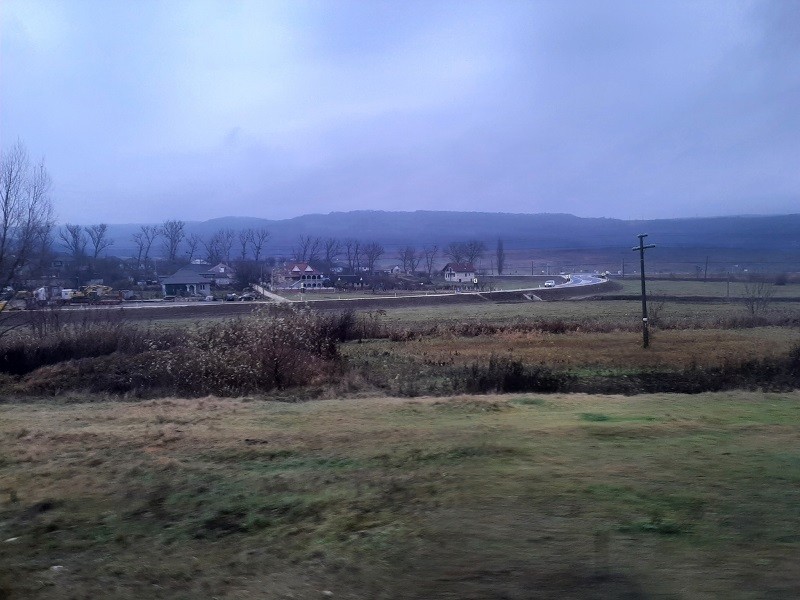
In the Moldovan hills
The best views from the Chisinau-Iasi train are roughly between the towns of Sipoteni and Pîrlița.
Here, the railway line was built high up a hill, which means that you can enjoy some sweeping views over the Moldovan countryside from all sides of the train.
It certainly helped as well that the weather cleared up by now and some blue skies appeared over the Moldovan hills as almost immediately everything started to look more scenic.
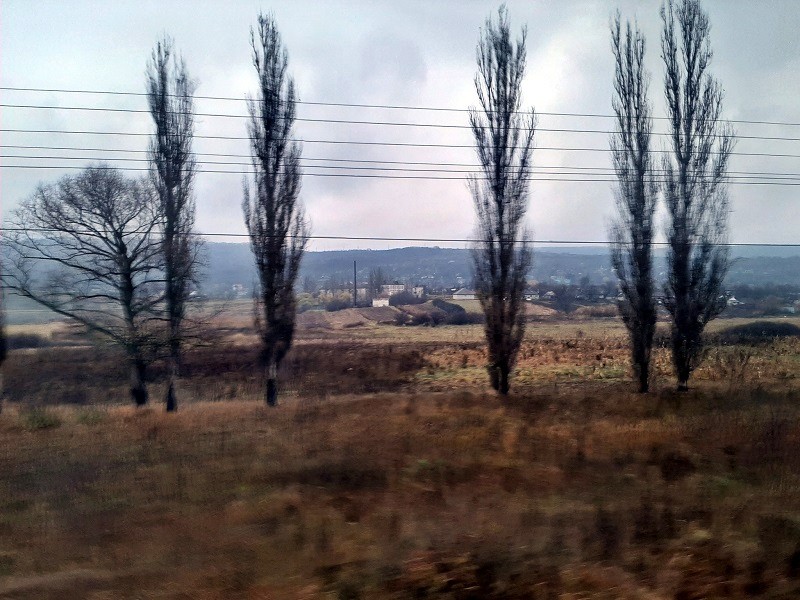
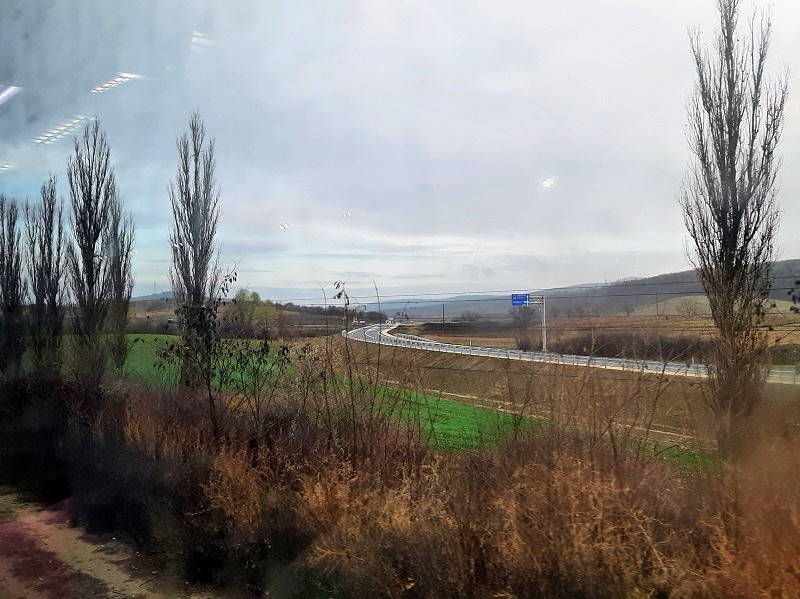
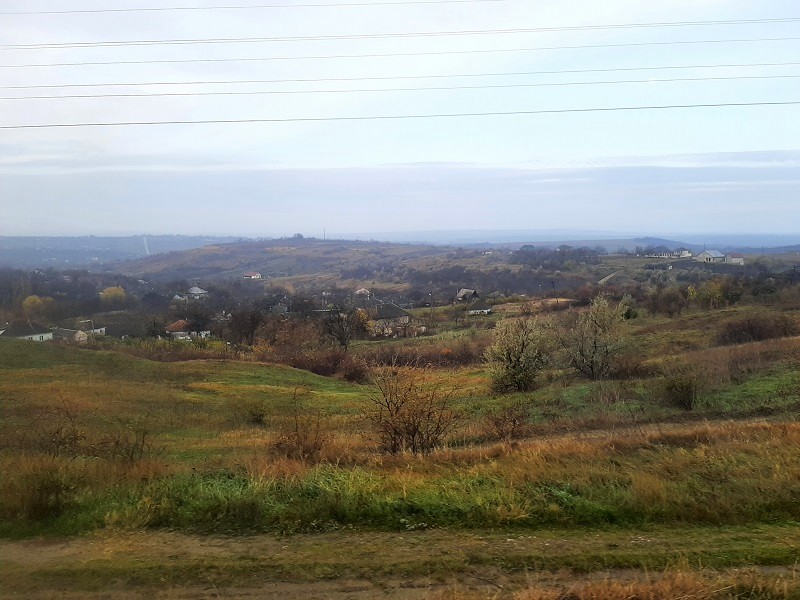
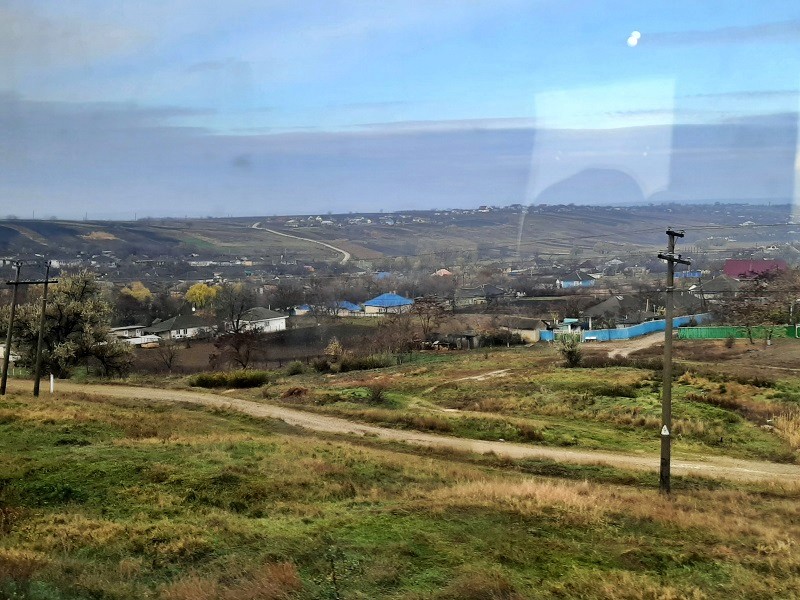
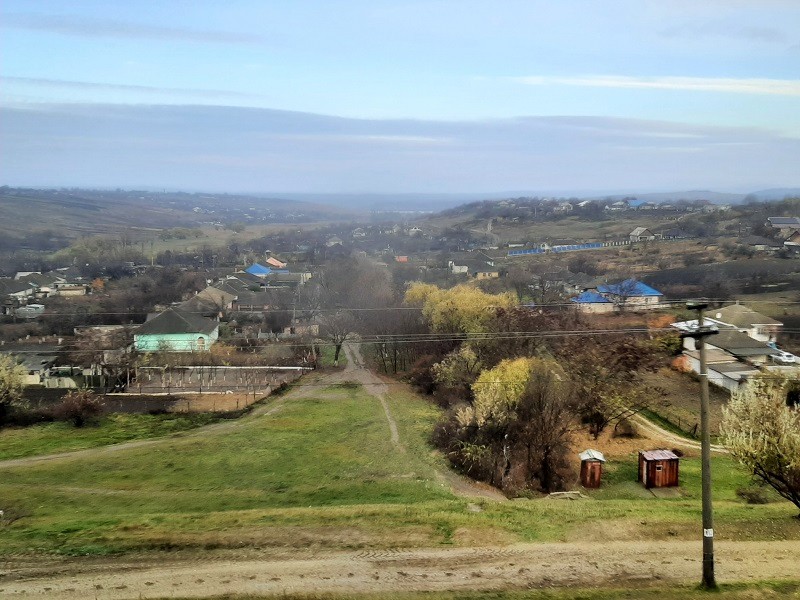
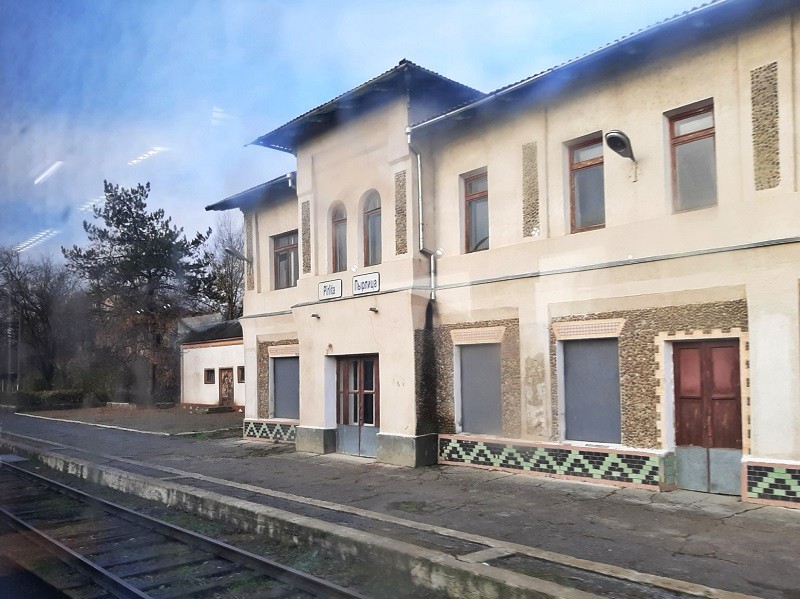
Ungheni border
After the CFM Moldovan Railways train has passed the station of Pîrlița, it will run downhill towards Ungheni.
With a population of around 35,000 inhabitants, Ungheni is one of the largest towns in Moldova.
Ungheni is also the Moldovan border station and border guards will enter the train here to check passports.
The Moldovan border guards simply collect the passports of all passengers, take them to their office for checks, and return about half an hour later with the stamped passports in hand when they are finished.
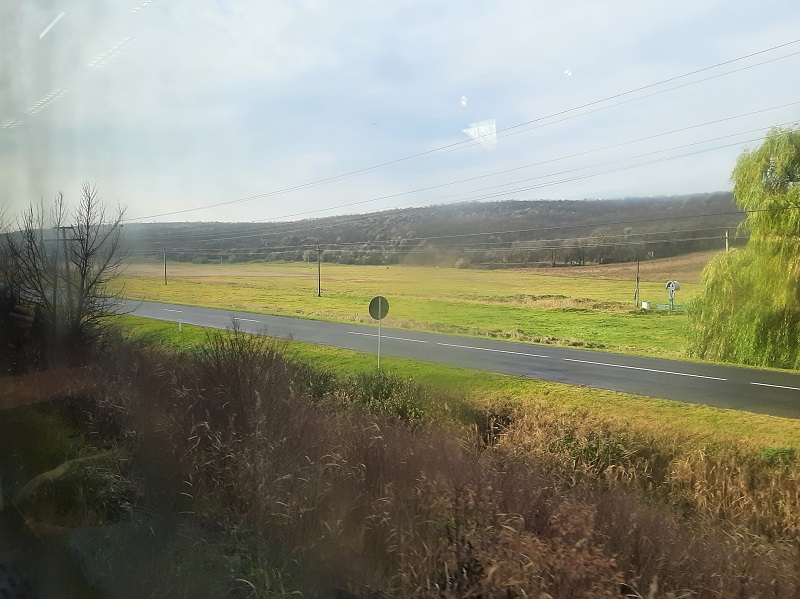
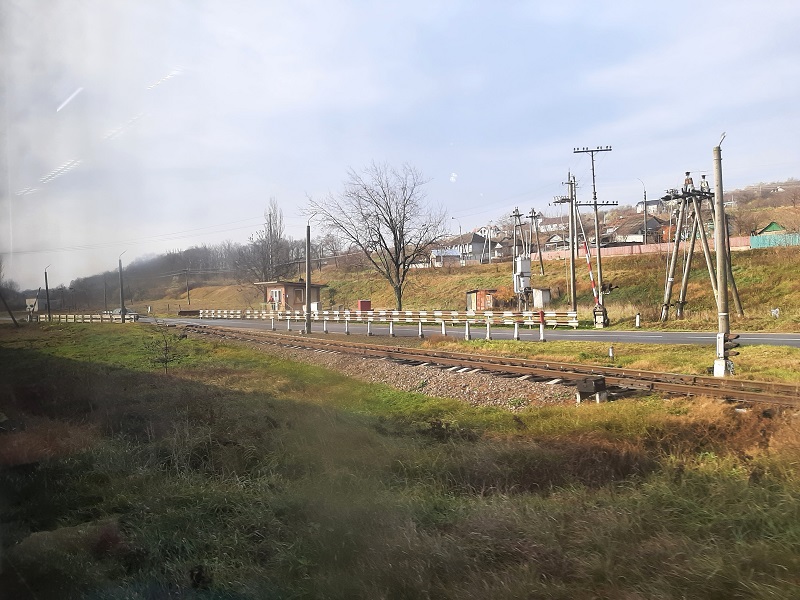
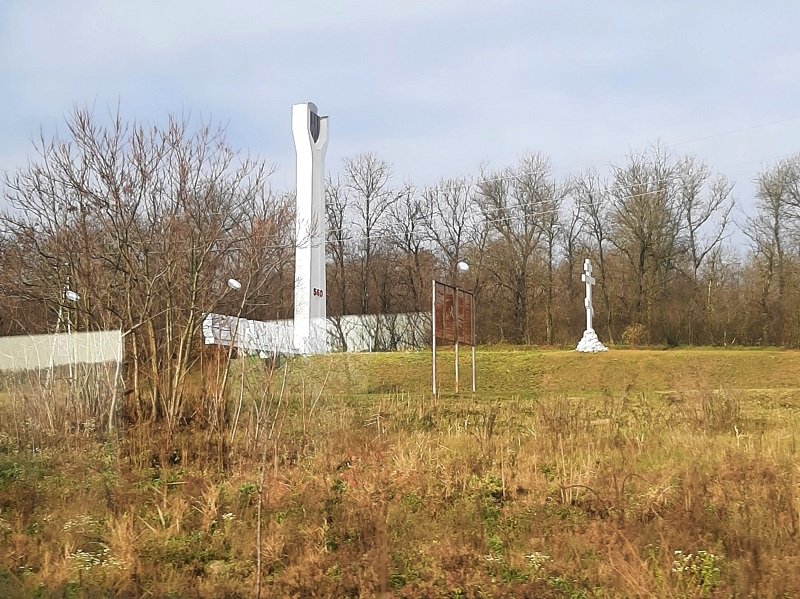
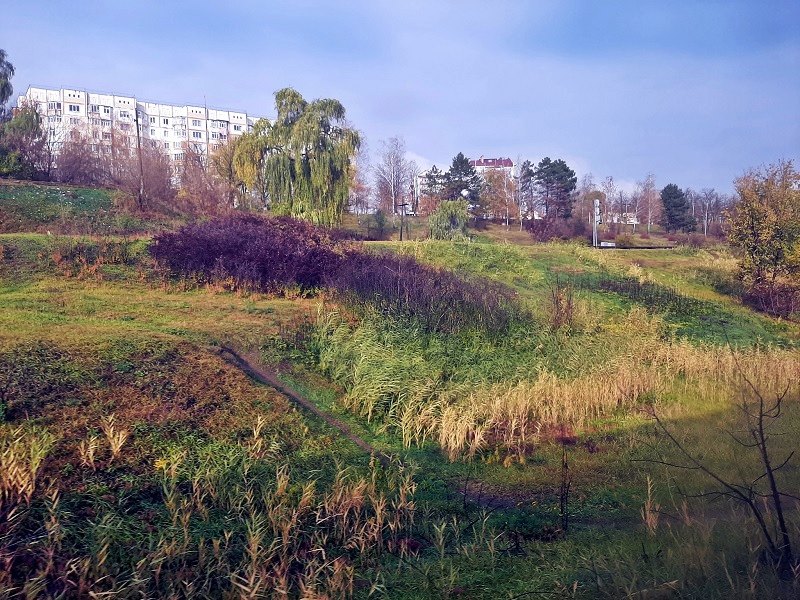
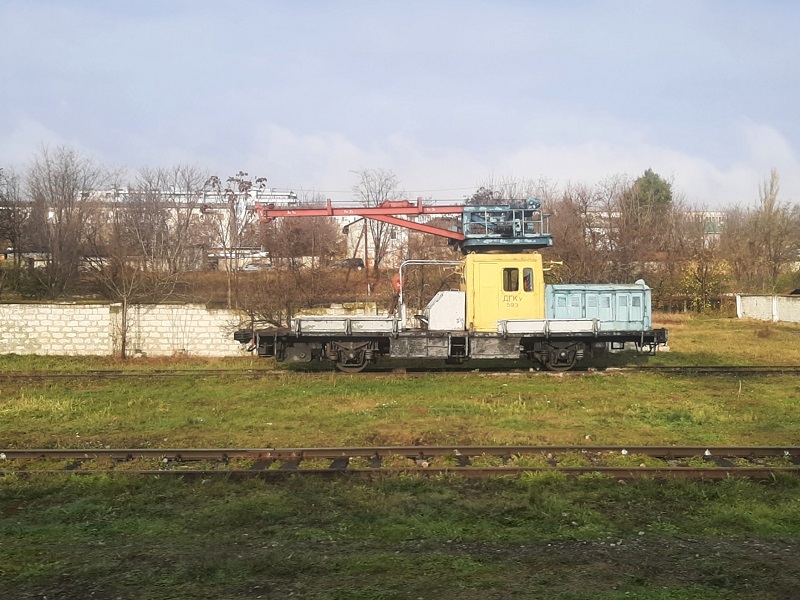
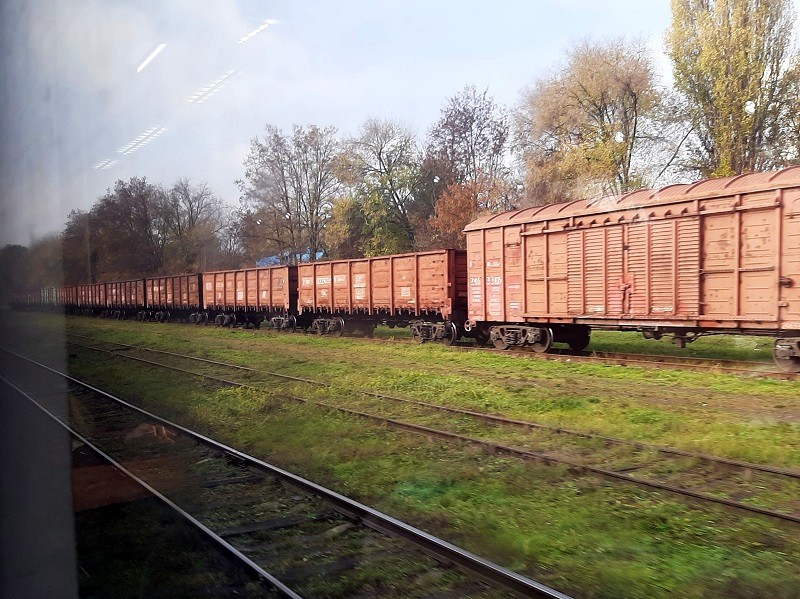
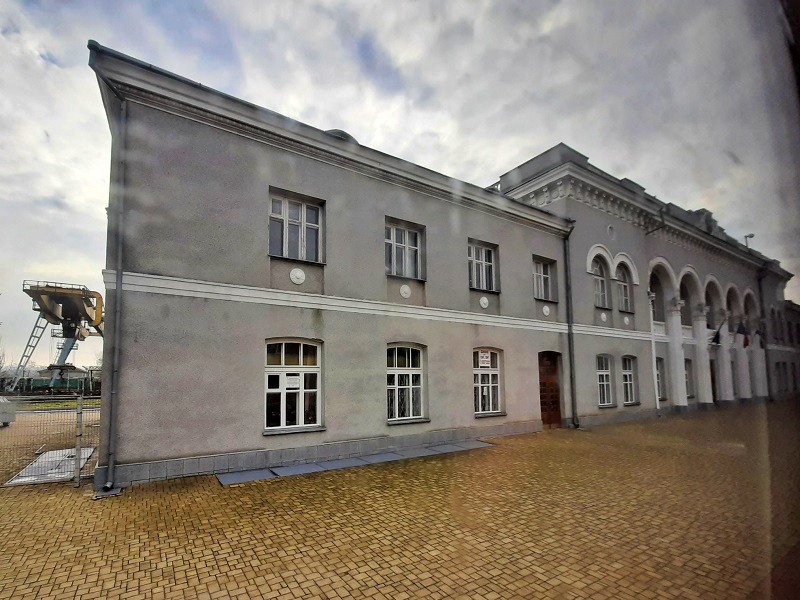
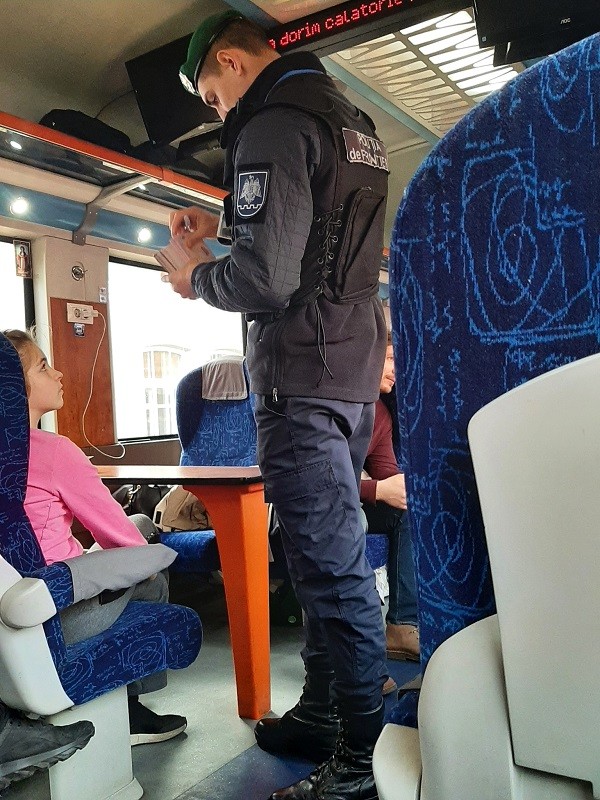

Crossing the River Prut
The actual border between Moldova and Romania is formed by the River Prut, one of the tributaries of the mighty Danube.
Although the River Prut may look like a natural border, it actually isn’t.
For many centuries, the people on both sides of the river lived together in the same country, whether this was during Medieval times in the Principality of Moldova or in Greater Romania during the interwar period.
Indeed, the people on both sides of the river share the same Romanian language and culture.
The modern-day border between Romania and Moldova is a Soviet creation from after the Second World War.
It split the town of Ungheni in half – with the biggest part of the town being located on the left bank of the River Prut in Moldova and the small part of town on the right bank being located in Romania.
The Romanian border station at the other side of the river is therefore also named Ungheni – although you often find it on international timetables as “Ungheni Prut” to set it apart from the Moldovan station.
Romanian border
The Romanian border station of Ungheni Prut exists out of some makeshift containers.
The procedure on this side of the border is the same.
Again, border guards will enter the train, collect everyone’s passport and return with them about 30 to 40 minutes later.
However, you can expect customs checks to be a bit more serious on the Romanian side as the train does enter the European Union (EU) at this border.
Border guards will be extra vigilant for people trying to smuggle large quantities of cigarettes and tobacco across the border.
It was sad to see the many stray kittens in the cold outside at the station – I do hope the Romanian border guards do take care after them!
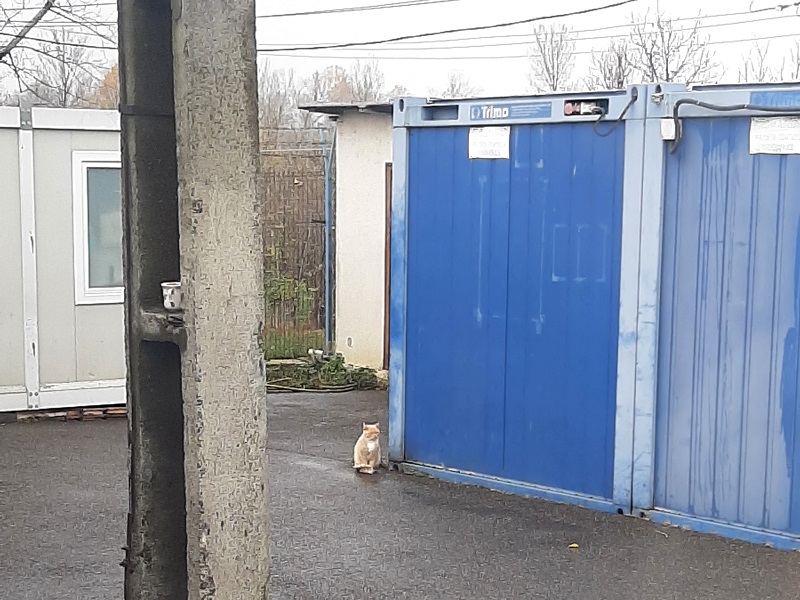
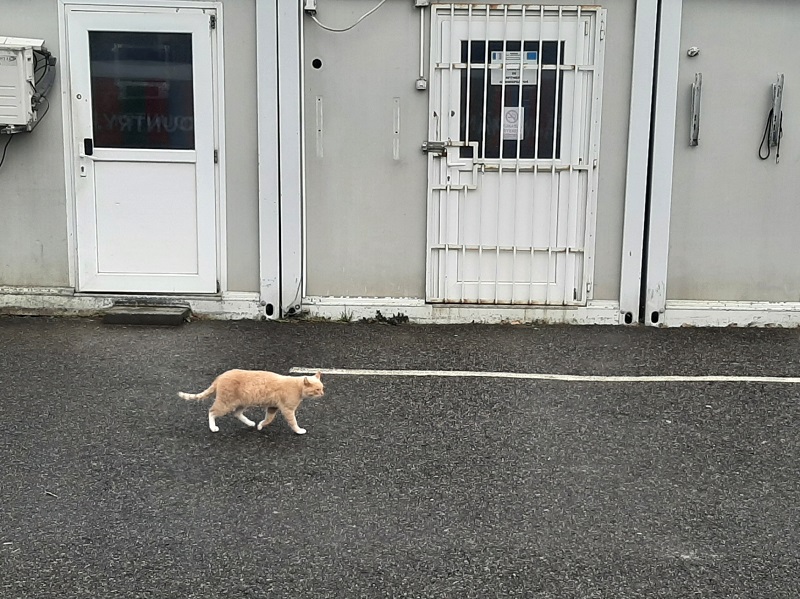
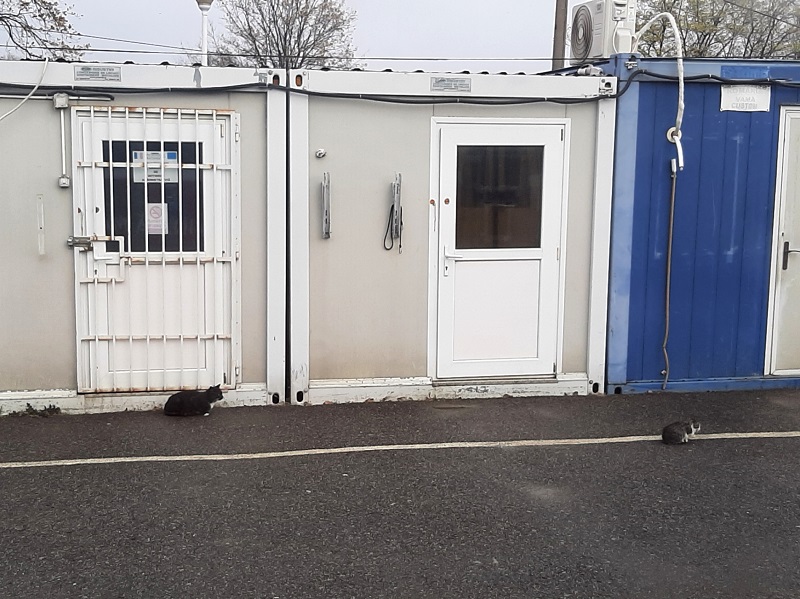
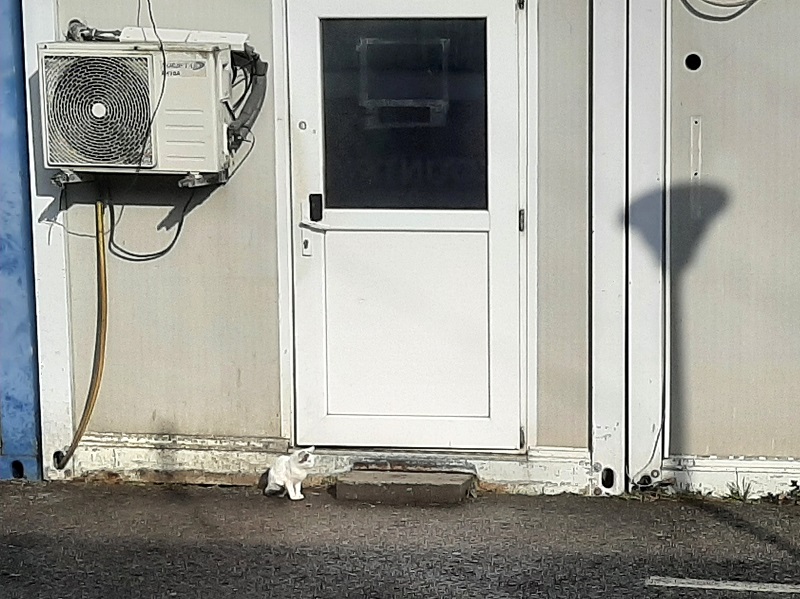
Towards Iasi
After departure from Ungheni Prut, the CFM train makes one more stop at the station of Cristești Jijia before continuing to its final stop in Iasi.
The border between Moldova and Romania isn’t too far away from Iasi, as it takes the train just 20 to 30 minutes to cover this distance.
At this point, I was starting to get a bit tired of the journey.
While I found the seats quite comfortable at the start of the trip and think they are perfectly fine for a short journey, I thought that sitting for nearly 5 hours in them is pushing the limits of their comfort.
It doesn’t help that this CFM Moldovan Railways train remains rather noisy and that the ride quality isn’t the best.
Even the most thorough renovation and modernisation works cannot change these typical characteristics of what essentially still is an old Soviet-era train.
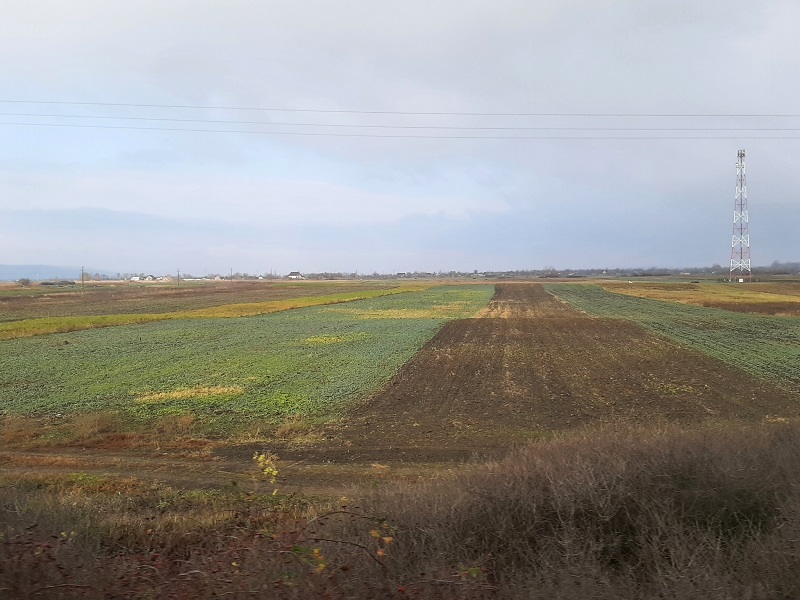
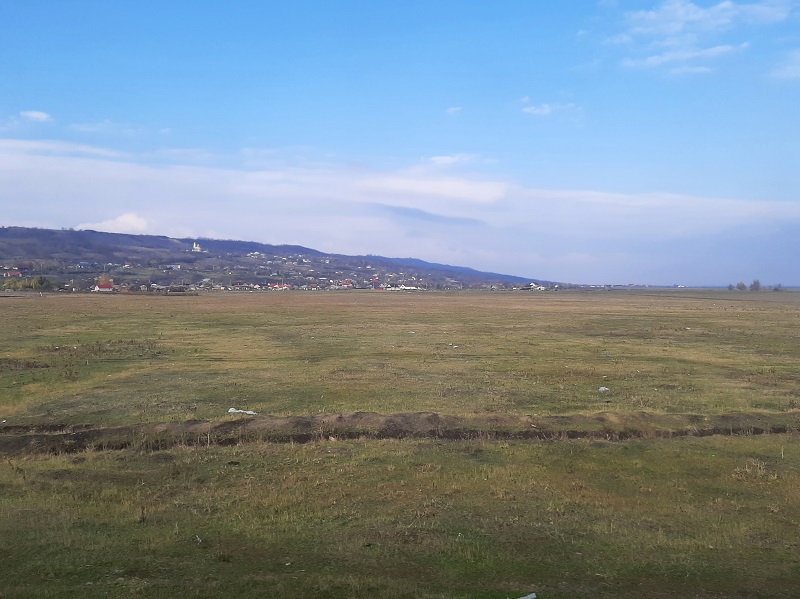
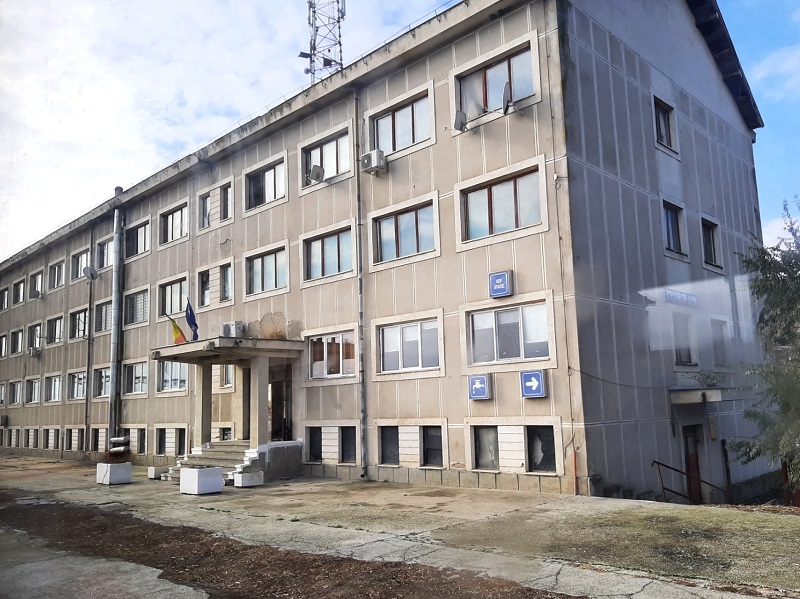
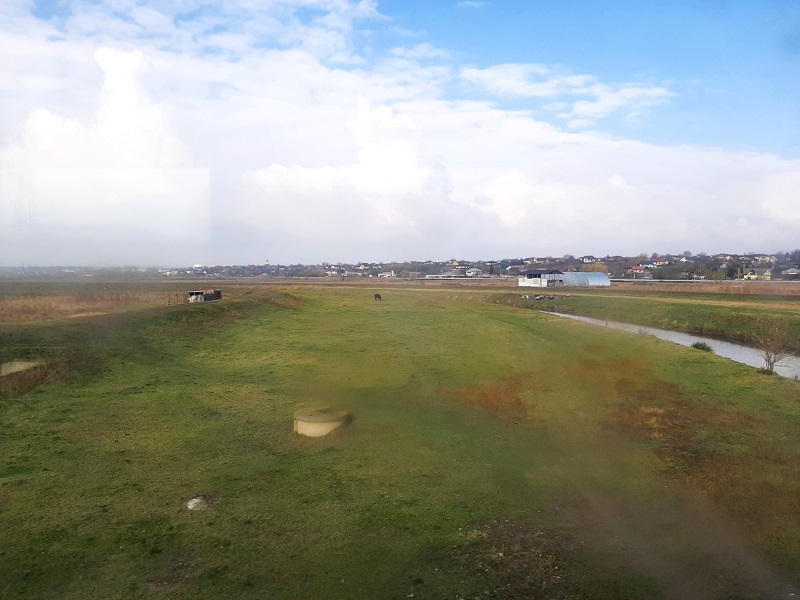
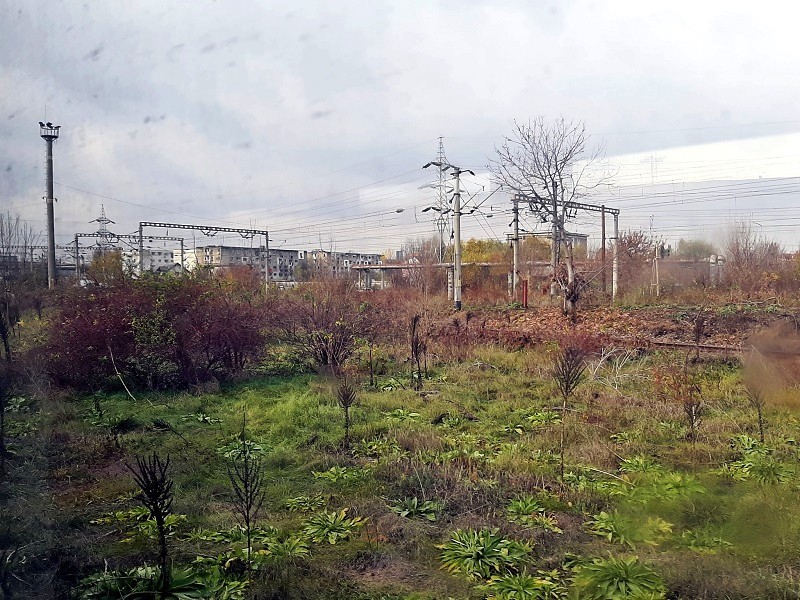
Iasi Socola station
My train eventually arrived at the station of Iasi Socola with a 30-minute delay, which I think was mostly due to a longer than anticipated wait at the Romanian border station.
Socola is essentially a freight station and some sidings at the outskirts of Iasi.
The reason why the Chisinau-Iasi train uses Socola station and not the main station in the city centre has to do with the different railway gauge.
Moldova uses broad (Russian) gauge tracks (5-foot wide), while Romania uses standard gauge tracks (4 feet and 8.5 inches wide) just like most other countries of continental Europe.
However, from Ungheni there is a dual gauge railway line across the Moldovan-Romanian that runs all the way towards Iasi Socola station.
Because of this, the CFM broad gauge train can travel all the way to Iasi Socola without having its bogies adjusted to standard gauge tracks, a time-consuming process which would have been needed if the train used the main station of Iasi instead.

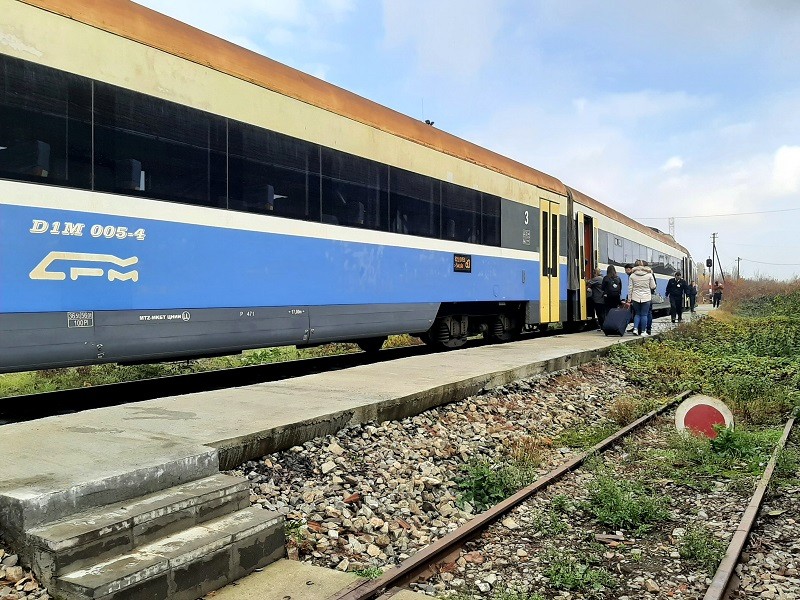

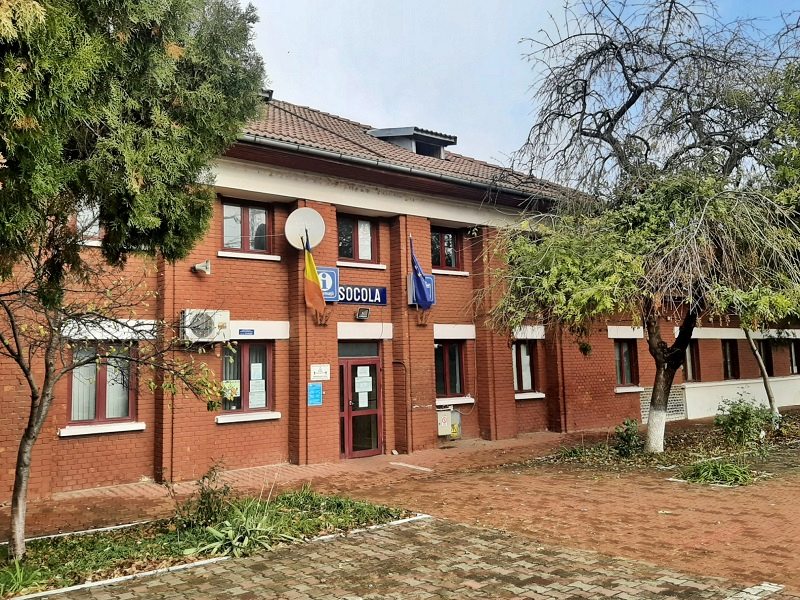
From Socola into Iasi
Even though the Chisinau-Iasi train doesn’t use the most convenient station in Iasi, CFM Moldovan Railways has organised a great bus connection to the city centre in cooperation with the local transport company of Iasi (CTP).
On the main road in front of the station, buses will wait for each arriving train from Chisinau.
These buses bring you to the Palas Shopping Mall in the city centre of Iasi for 3 RON (€0.60) – payment by card should be possible too.
Alternatively, you can order a taxi or Uber for just a few euro to take you from Socola to the city centre, main railway station or Iasi Airport.
If you are travelling the other way around and need to reach Socola station in order to catch the train to Chisinau, it might be easier just to take a taxi or Uber as finding the right stop for the infrequent bus to Socola (bus number 51) can be tricky.
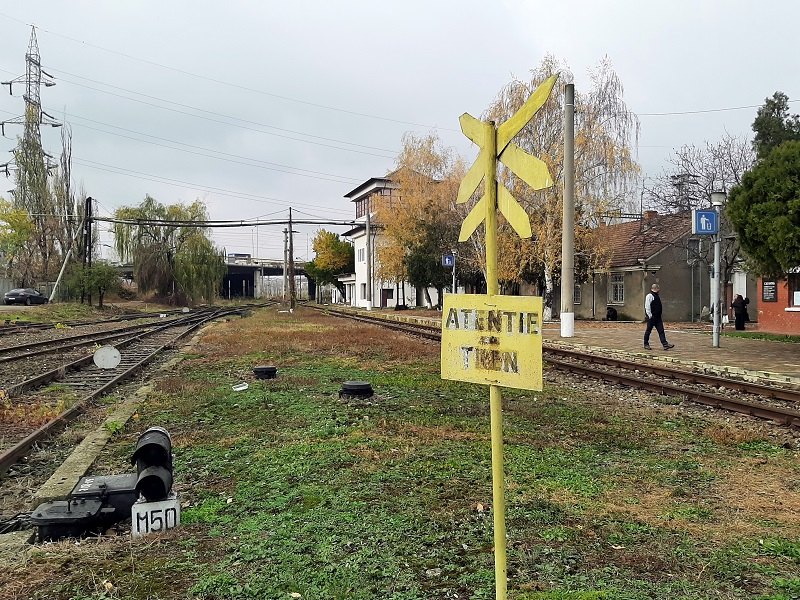
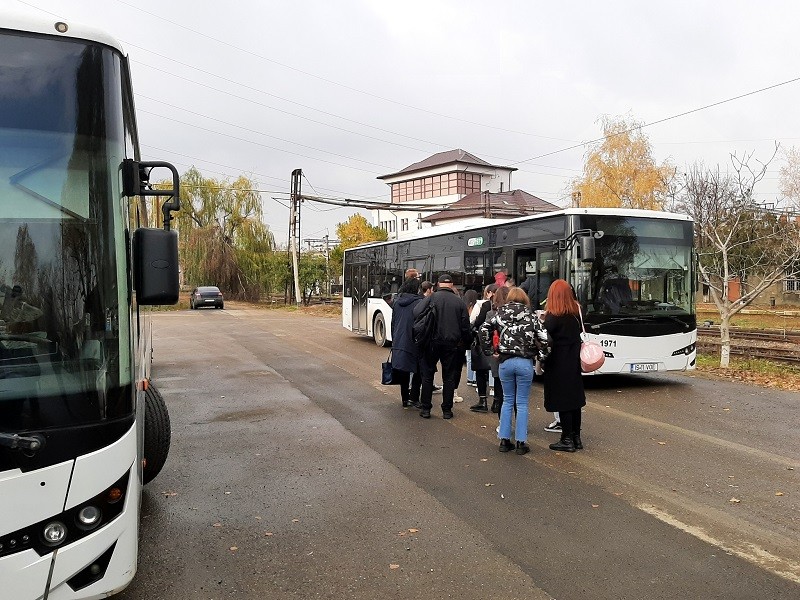
Onward train connections
I took the bus towards the city centre of Iasi and simply walked from there to the beautiful main railway station of Iasi, which was built in Venetian-Gothic style.
At the main station of Iasi you can easily connect to the afternoon train to Suceava, Gura Humorului (for the Painted Monasteries of Bucovina) and Cluj-Napoca, one of the two afternoon trains to Bucharest or perhaps the night train to Timisoara.
However, Iasi is certainly an interesting city to explore so by all means do stay for a night in town before moving on towards another destination in Romania!
As the last train from Iasi back to Chisinau leaves at 5.40pm, it’s also perfectly feasible to use this service if your starting point might be another Romanian city.
You can for example easily take the morning train from Bucharest to Iasi and then connect to the Socola-Chisinau train if you prefer daytime trains above the direct Prietenia sleeper train between Bucharest and Chisinau.
Tickets for Romanian trains can easily be booked online at the website of national railway company CFR.
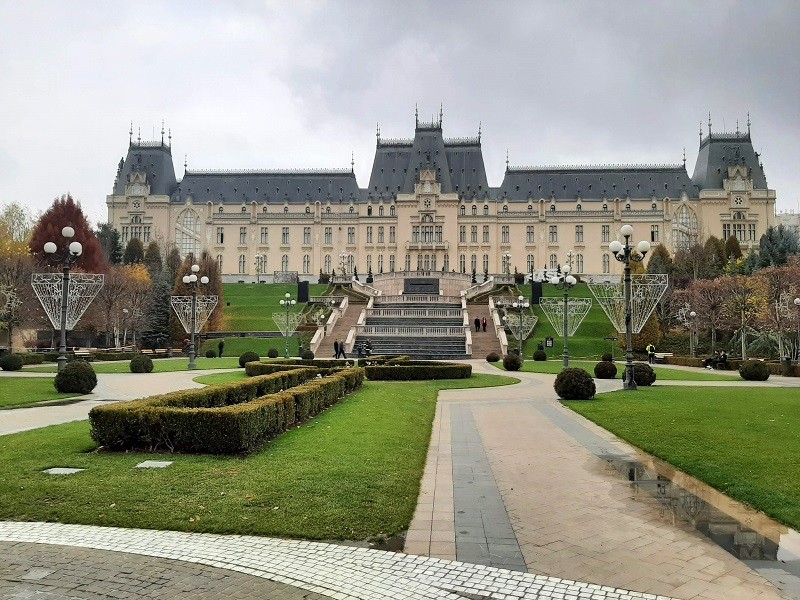
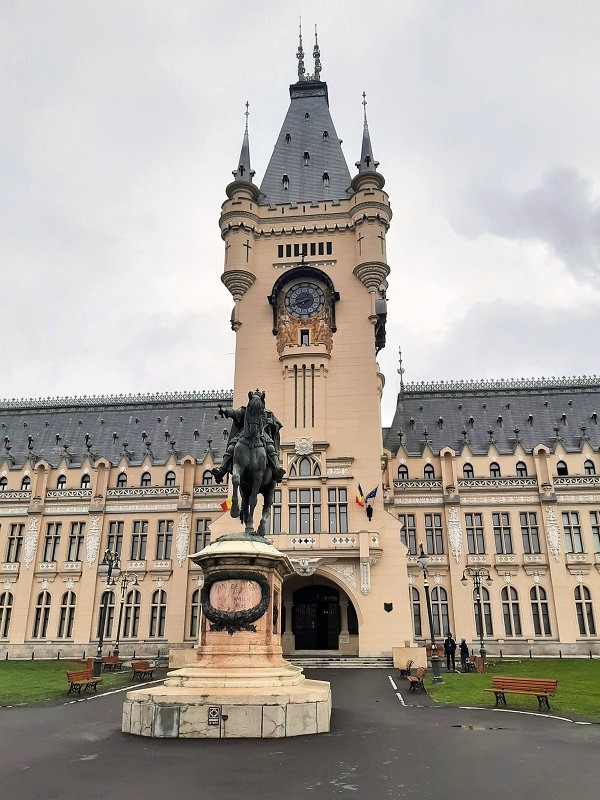
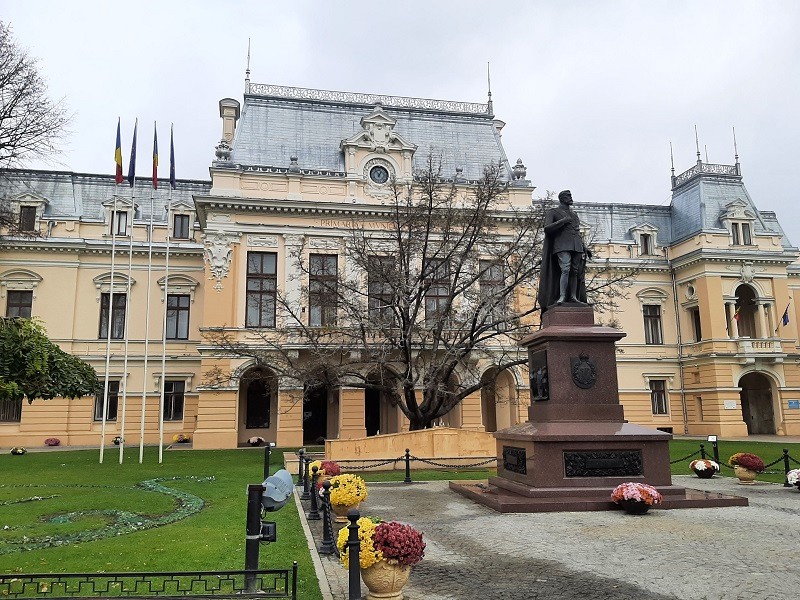
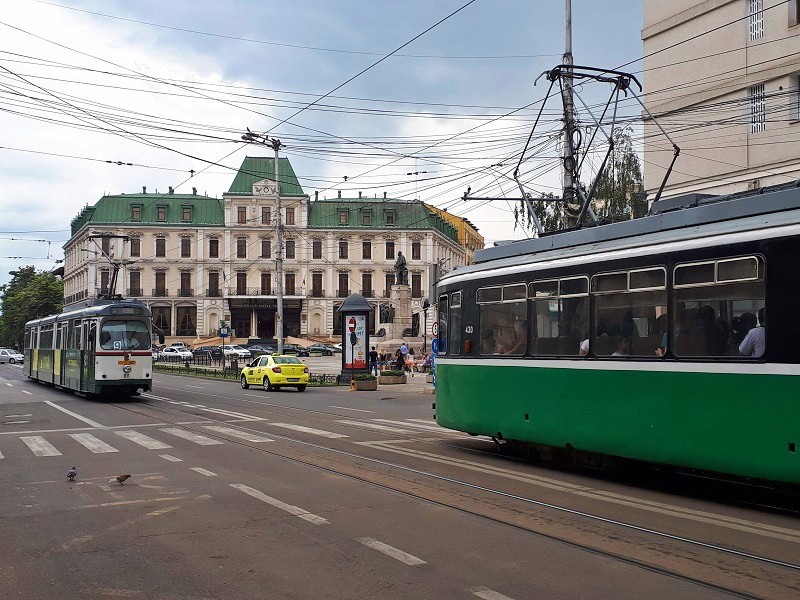

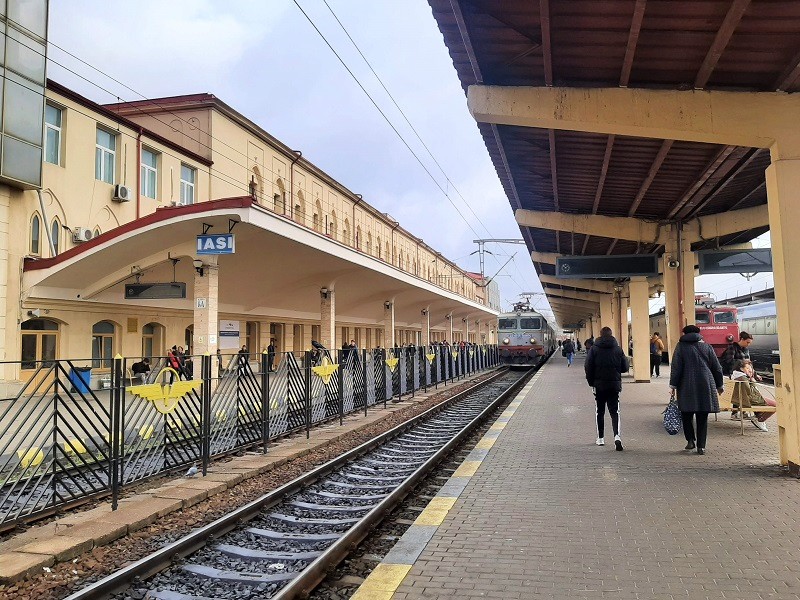
Conclusion
The Chisinau-Iasi train operated by CFM Moldovan Railways is a convenient link between Moldova and Romania.
Although the train between Chisinau and Iasi takes longer than a bus, it is a more comfortable way to travel between these two cities.
The train is perfectly affordable as even a first class ticket will only set you back €6.30.
On the Chisinau-Iasi route, CFM Moldovan Railways uses an old Soviet diesel multiple unit (DMU) train which has been completely remodelled and modernised.
It certainly makes for an interesting journey and on a sunny day the views from the train of rural Moldova are quite enjoyable.
There are however some downsides too.
Apart from the long travel time, the biggest negative of the Chisinau-Iasi train is the fact that it uses the secondary Socola station on the outskirts of Iasi, so you’ll need a bus or taxi to reach the city centre or main train station.

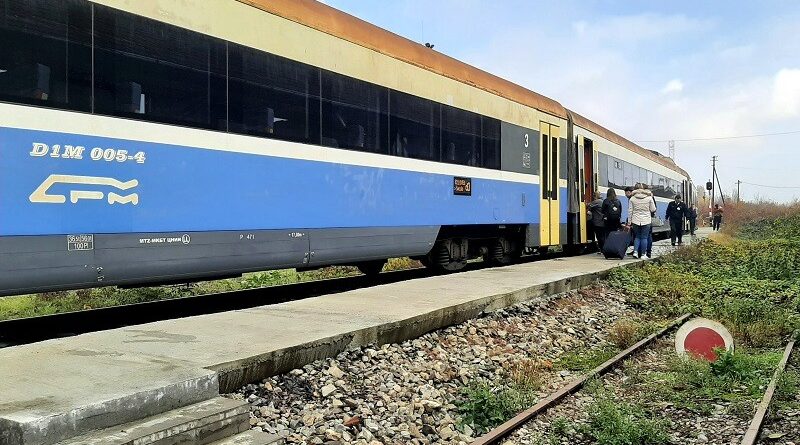
Thanks Koen, another interesting report from a pretty obscure place – I keep thinking I want to visit Chisenau but perhaps not at the moment.
Thank you so much! I was debating between the train and bus to go back from Chisinau to iasi and this sold me on the train!